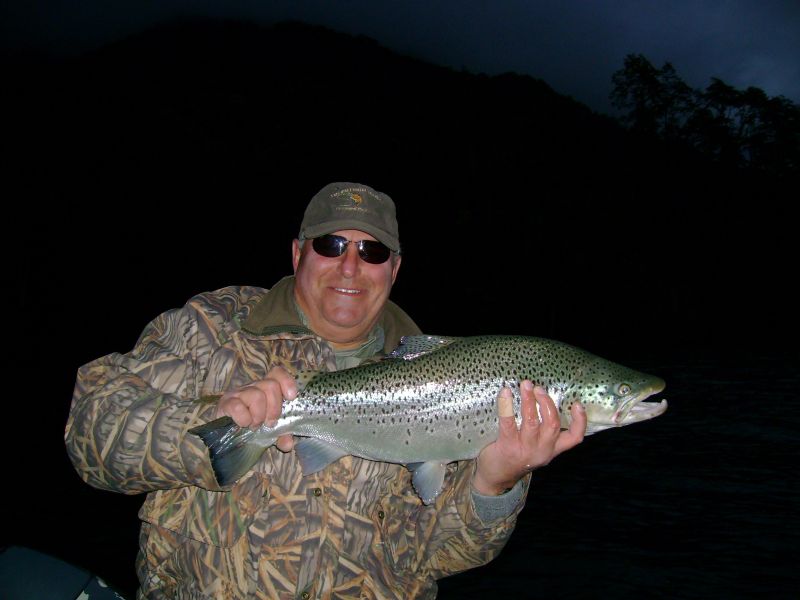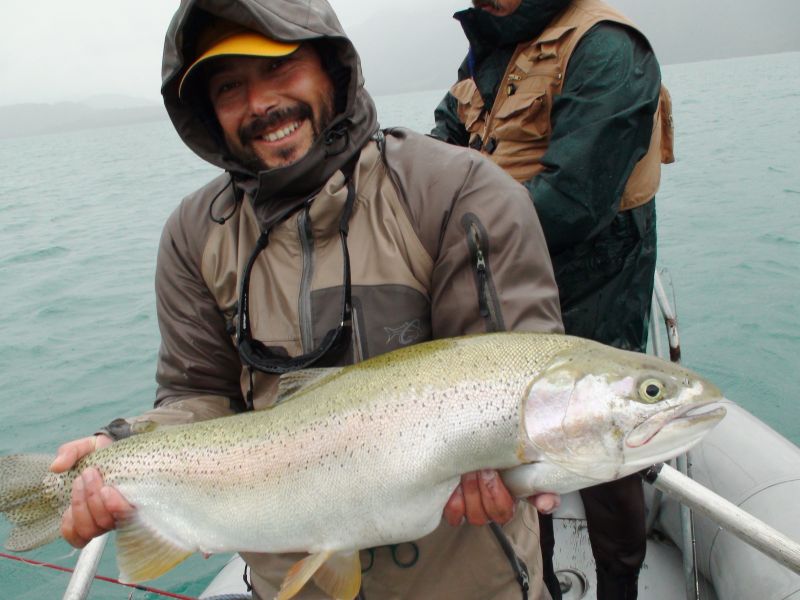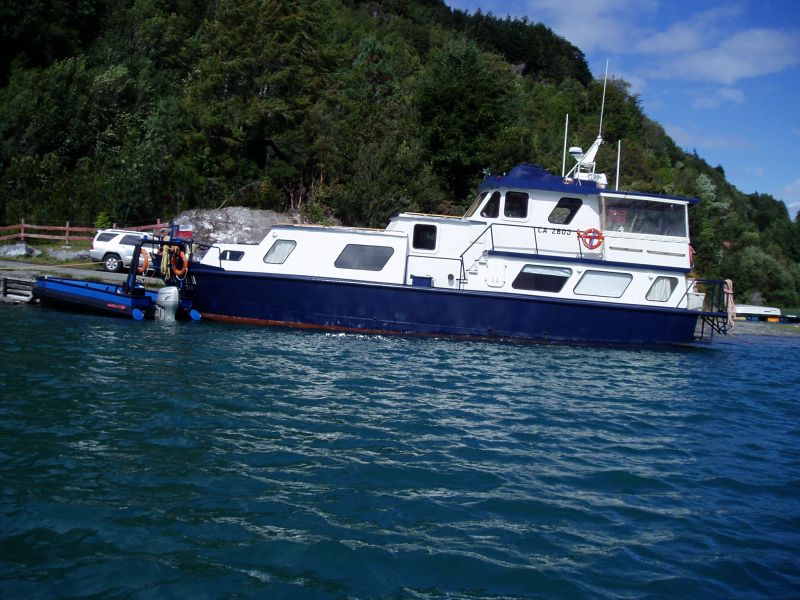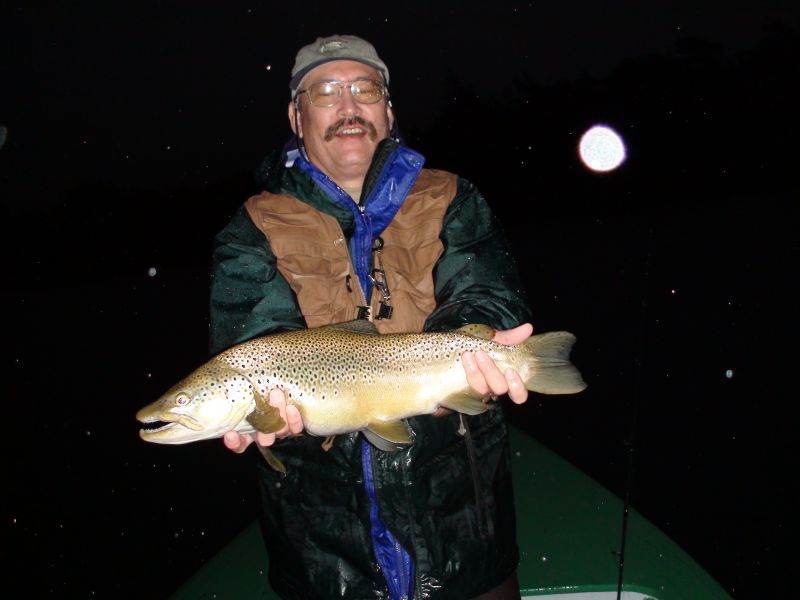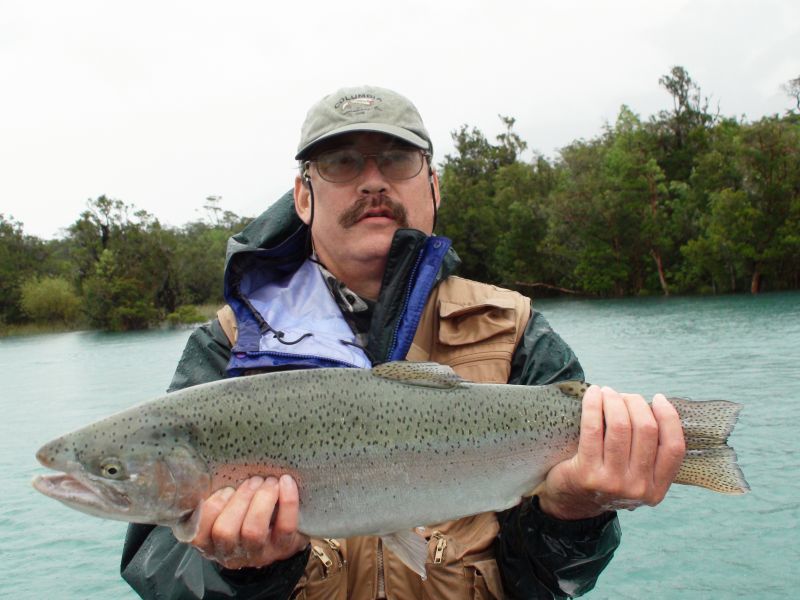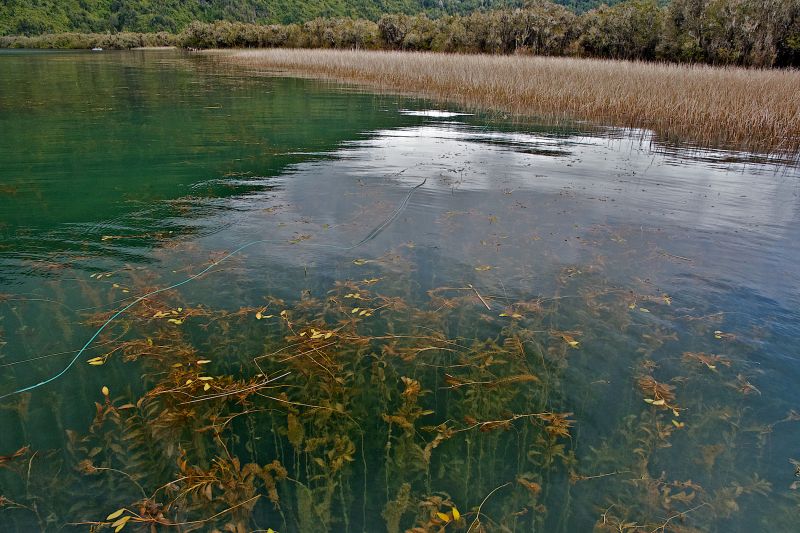
I would like to thank all of the clients that we had the pleasure of letting us share the "Magic" of our fisheries with;as well as, our hard working staff that made the season so enjoyable for all.
The fishing in Lake Yelcho was again superb. For example, annual guest, Huw Llewellyn and I each brought to net over 20 of the quality trout per day for 3 consecutive days! Huw came up with a new puye pattern that proved extremely productive in the lake as well as in the river. This pattern not only prove itself when large schools of trout were feeding on them at Puerto Cardinas but also in other areas of the lake and is a welcome addition to the fly patterns that we have been able to dial in on with fantastic results.The caddis hatches were very productive each evening and in certain areas the mouse patterns made for wild action in the evenings just before dark.
The Yelcho river again provided some very productive days, especially the sight fishing to sipping trout with caddis, emergers and puye. Several trophy browns were hooked and if the fishing Gods saw fit, their photos were taken. Return angler Paul Pare did especially well targeting big browns with his spey rod. Return guest Gerry Wendrovsky had another heart breaking battle with a monster brown on his last day of fishing - hopefully the third time will be a charm for him as he is an excellent fisherman and we hope to see him again next season. The Chovanes' elected to spend their honeymoon with us and left with big smiles on their faces.
Speaking of smiles and a positive attitude, the Nicholl/Holtz group were real troopers as two fronts came through during their week but they keep on fishing and not only had good sucess but also made the weather related challenges minimal for all of us. This group was one of the best that we have ever had the pleasure of serving. Will Nicholl made a wonderful video of their stay which is certainly worth watching and we recommend it to all anglers.
The ocean fished well for the tuna and mackeral when the weather permitted and most clients that went to the ocean caught both species and enjoyed the feast on the fresh mussels that we steamed during our shore lunch.
A miracle did occur this season as the Sage XP and 8/9 Nautilus reel that I lost when I lost my balance and fell in the lake last season finally turned up. We had scuba dived for it and dragged the area several times but could not locate the gear. But after two days of Argentine winds the rod tip surfaced and guide Rodrigo spotted it. We cleaned up the rod and reel and they worked fine after spending over 11 months in the lake - this sure speaks to the quality of the equipment, especially the Nautilus reel which with its sealed drag system worked perfectly. In fact, I brought the reel up to use bone and snook fishing in Florida this summer. What a lucky find after almost of year of searching!!
Another highlight of the season was when Sargent Major Calvin Boersma caught the Patagonia trout grand slam from the deck of Puma II before the other members of the group even had their gear put together. Calvin's puye patterns that he sent back down to us were quite effective -- thanks Calvin.
The one disappointment of the season was the Chinook Salmon run. This down trend apparently involved the whole coast of Chile for the second season. The cause of this is unknown at this time and their are several theories but no proof of the actual cause or causes. There was a partial decline 3 seasons ago and the last two seasons have shown a dramatic decline. We sure hope that this is temporary as we have enjoyed fantastic Chinook fishing in the past and for BIG KINGS, as our IGFA world records confirm.
Again thanks to all that made our season a success!
SUMMARY OF THE 2017-2018 SEASON:
SUMMARY OF THE 2016-2017 SEASON:
Again I would like to thank all of our clients that allowed us to share the magic of the Yelcho with them. I would also like to thank my staff who did another magnifient job of making the season enjoyable and successful.
The season began with fishing in the river and lake being its usual excellent quality for Nov. & Dec.. We had a nice run of steelhead which was unusual on the Yelcho. December's dry fly fishing was superb. In Jan. la nina reared its ugly head and we had rain and the barometer bouncing most of the month - which is quite unusual. The first part of Feb. saw the weather settle, then during the last part of Feb. it started raining again and during one week it rained all day, every day. The Mitchell, Roth, Goodsel group were real troopers and managed to catch some very nice trout in the lake in spite of the weather - this showss that successful anglers adapt to the conditions. The Chinook run had started well, but the river blew out so bad that apparently the salmon did not come up the river to the degree that we expected. In fact, we experienced the worst fall run of Chinooks that we have ever had since we started targeting them. Apparently we were not alone as reports from other lodges and rivers all the way from north of Puerto Montt south endured the same experience so maybe our poor run was not entirely due to the extreme river blowout.
The first part of March we started fishing in the ocean; we had planned on starting in Feb. but weather and other factors delayed this fishing expansion. The best way to describe the action in the ocean is "WILD & EXPLOSIVE". Not only were we catching many large mackerel (everone called them Sierra Mackerel but they turned out to be Snoek or Snake Mackerek); but also were catching several tuna up to about 30 lb.. The tuna turned out to be what is called the Slender Tuna and commercial fishermen said that this is the first year that they have been present in any numbers. We are submitting IGFA world records for both of these fish -- unfortunately, neither species is on the list for length (catch and release) records nor any line classes so all that we could submit were the largest catches of these two species ever caught. In talking to the commercial fishermen, they say that the mackerel show up in the area in Dec. and stay until June. Having the water boiling with mackerel and tuna crashing bait fish while birds are diving (including Patagonia penguins) and feeding, throwing a fly or lure into the chaos and being rewarded with the rod almost ripped out of your hand is quite a rush. The best day was 3 anglers catching 11 tuna and 32 mackerel. For the 2017-2018 we plan to take clients to the ocean once during their stay, weather permitting.
The lake fished very good the entire year. Many trout in the 5-10 lb. range were brought to net along with several over 10 lb. The river fished good most of the season, except when it blew out once in Jan. and once in Feb..
The estuary where we fish for steelhead and was so productive last season is again damaged to the point that we decided not to fish it. It took over 10 years since the Chaiten volcano eruption destroyed the pools for them to reform. Now riffraff work done last fall just above the estuary has changed the course of the river and it now unfortunately shoots straight out into the ocean -- so again no pools. What a shame.
HIGH LIGHTS OF THE SEASON:
-Mike Pearce, who had never fished in his life, after a few lession, was a fish catching machine but almost had a heart attack when he hooked a large Chinook that almost jumped in the boat when it felt the hook.
-being able to share with Bill and Vicki Mitchell all that we have done with Pf since their last visit about 16 years ago.
-welcoming our new client, Royal Safari (Capt. Igor Grigorenko) and his Russian clientele. Igor is not only an excellent fisherman but also an accomplished photographer. You will enjoy his HD images and we hope to have some of his drone images soon.
-annual client, Huw Llewellyn with a nice tuna that a sea lion took away from him, including his fly line when the sea lion tangled the line in a derelict piece of three inch/50 ft. tow rope that was in the bottom of the ocean. Don't feel too sorry for him as he caught many tuna and mackerel.
-Paul Thorpe's sea run brown of about 16 lb. - Paul enjoyed his stay which is about his 16 year fishing with us.
-the first Russian group almost tying my current IGFA world record Chinook lenght record and just getting beat out of the mackerel record by return client, Bruce Jackson, the next week.
-the second Russian group catching a very nice sea run brown and one of the largest Atlantic Salmon that I have seen caught in our waters.
-catching a 34 inch, 20 lb+ Brown in the lake -- thank you fishing Gods.
-and lastly, finding out that Rich Roth and his wife, Vivian, and I were all born at the same hospital in Montana.
SNOEK OR SNAKE MACKEREL
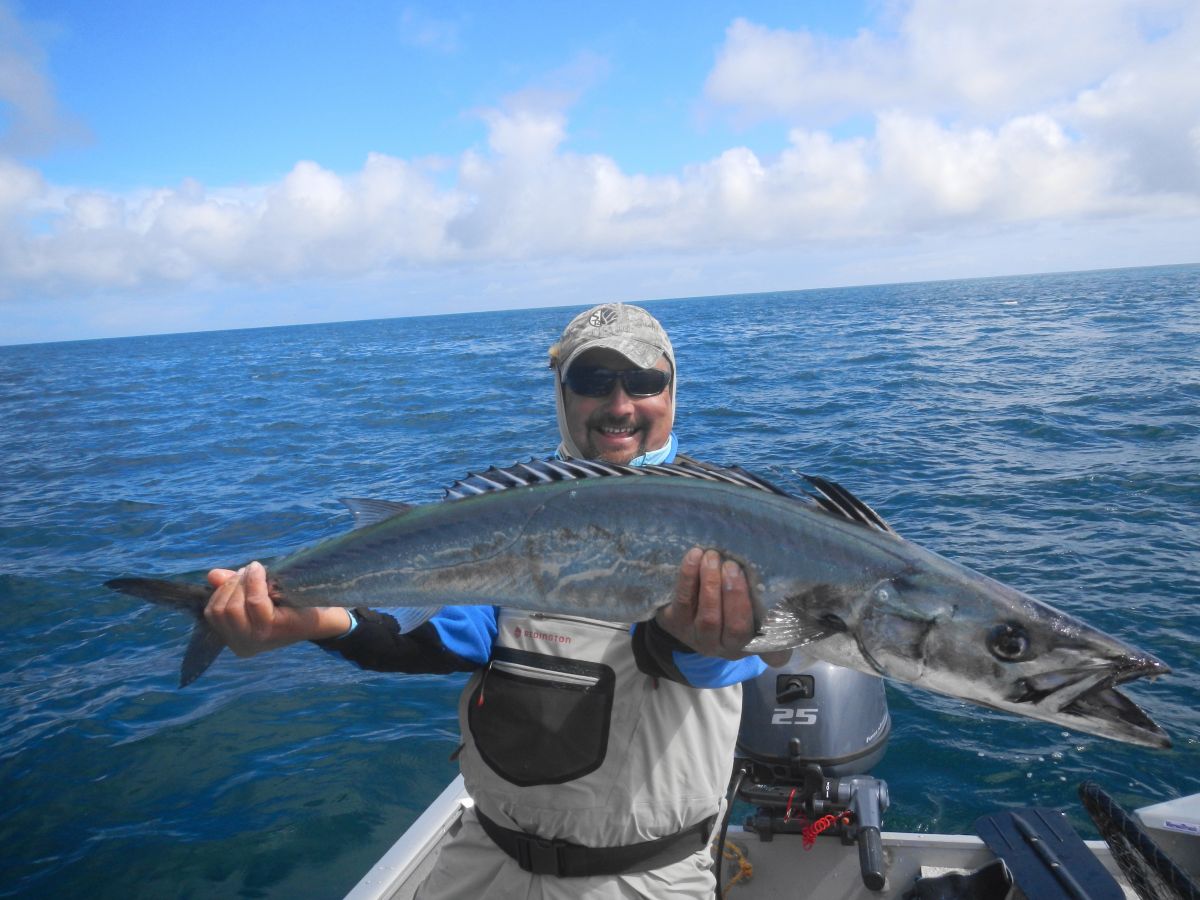
SLENDER TUNA
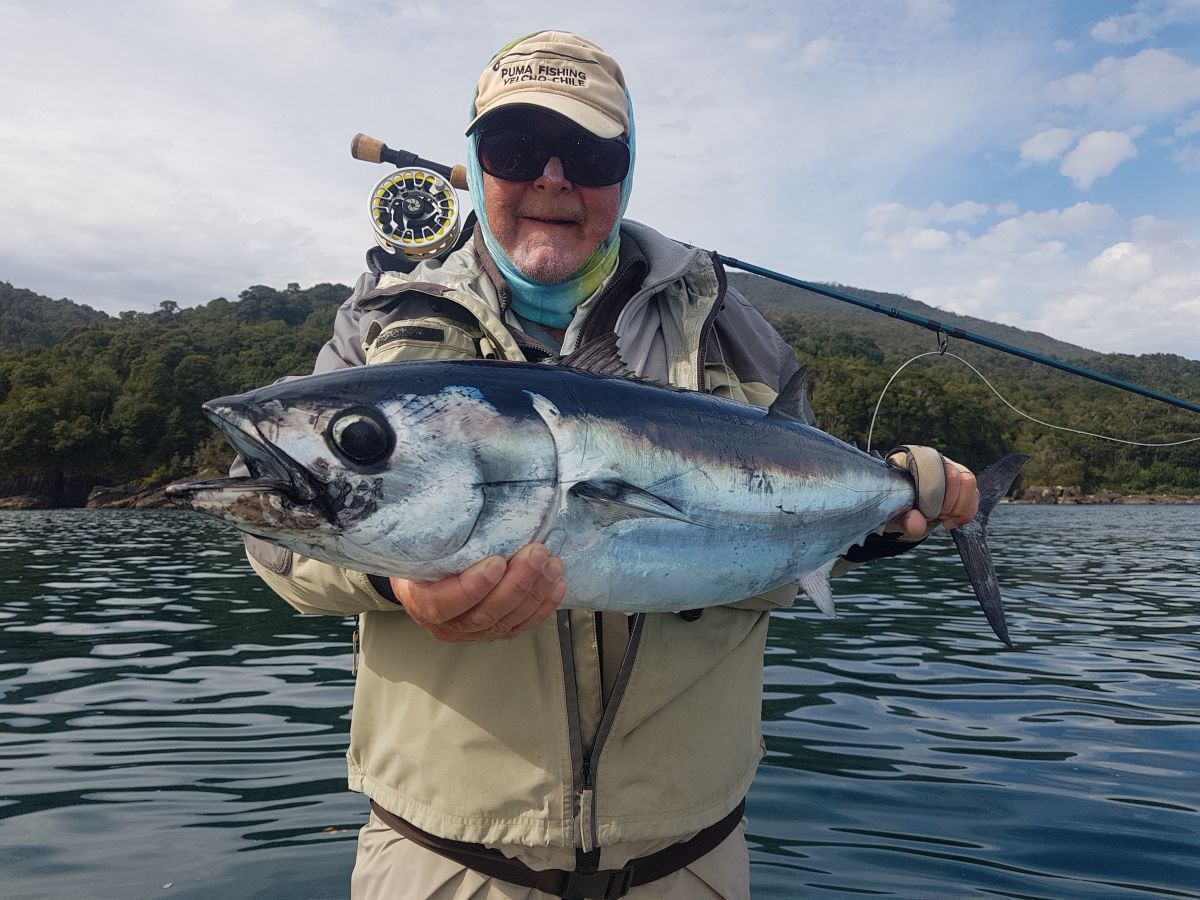
SNAKE MACKEREL & SLENDER TUNA
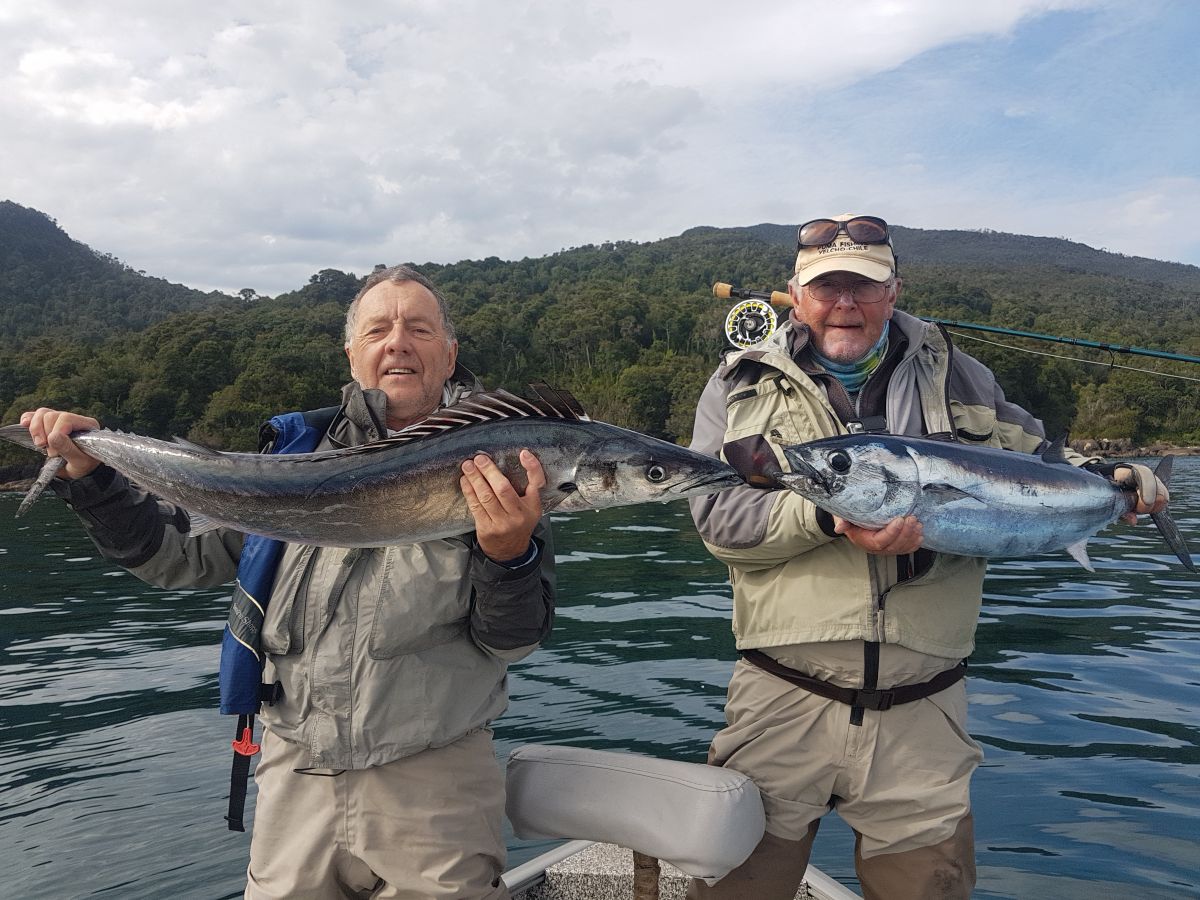
DOUBLE OF SLENDER TUNA
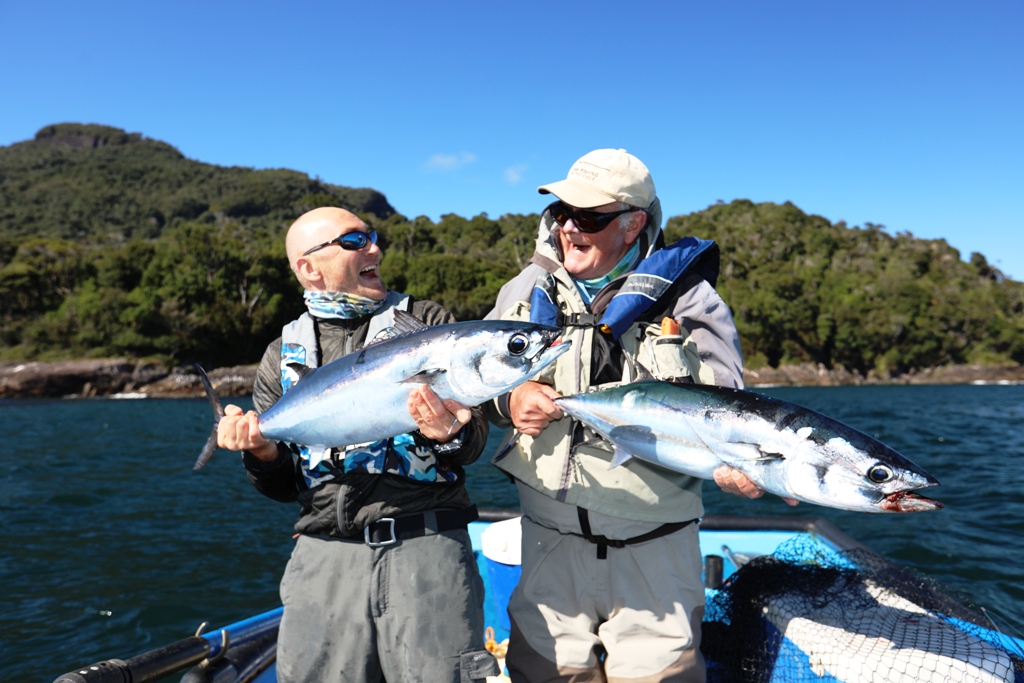
SUMMARY OF THE 2015-2016 SEASON:
I would like to thank all of our guests and my staff for a successful and memorable season. The percentage of return guests was very high so we must be doing something right.
THE DOUBLE
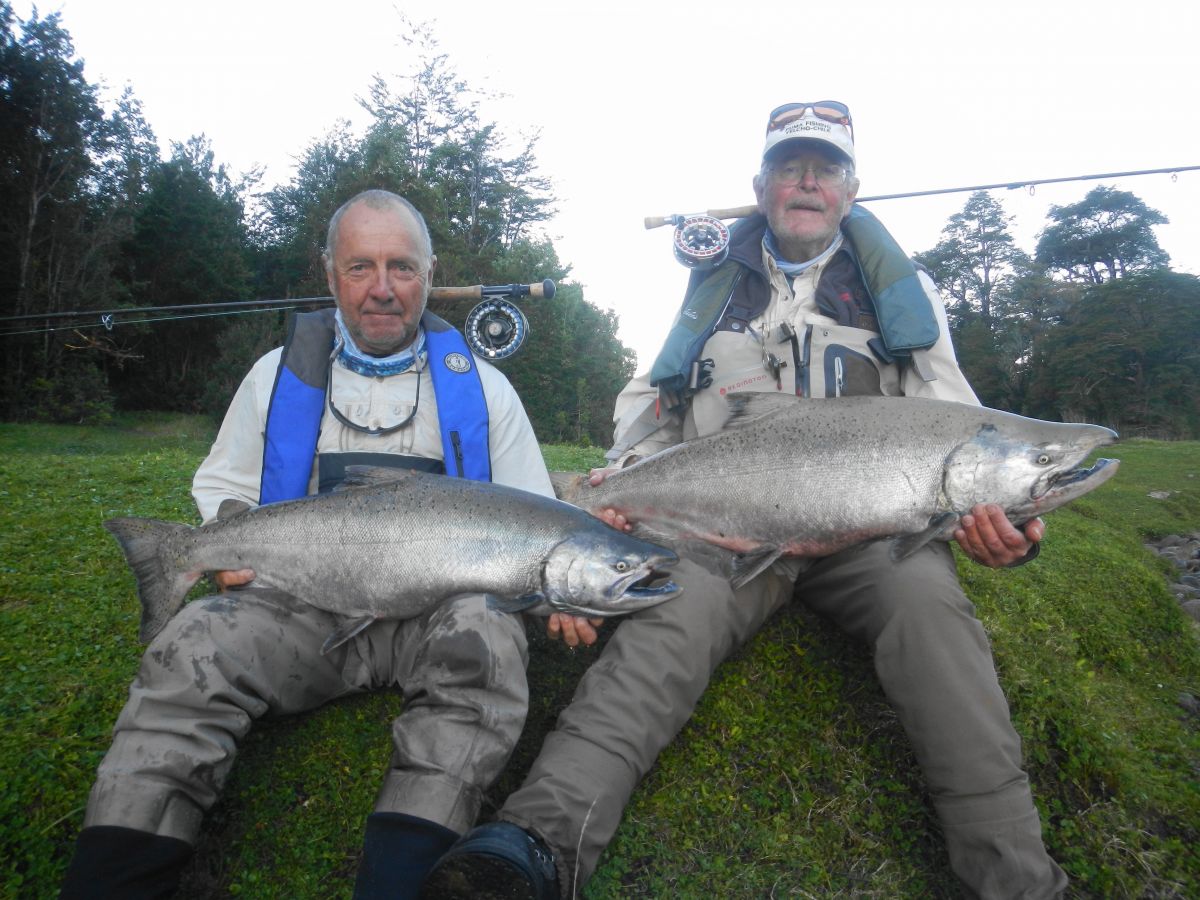
Dave & Kurt with trophy Brown on Yelcho River
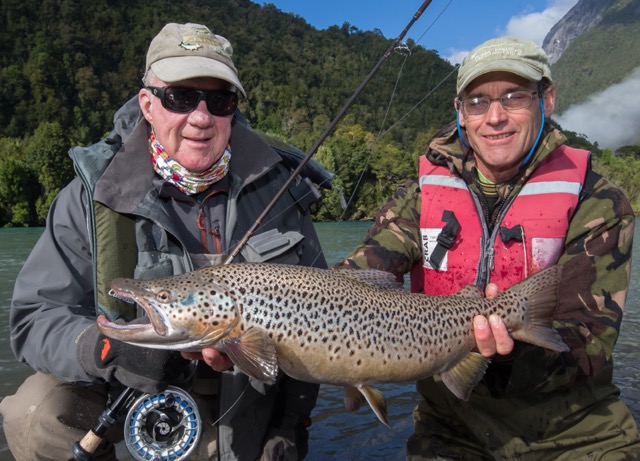
Fran with average/small Steelhead at estuary
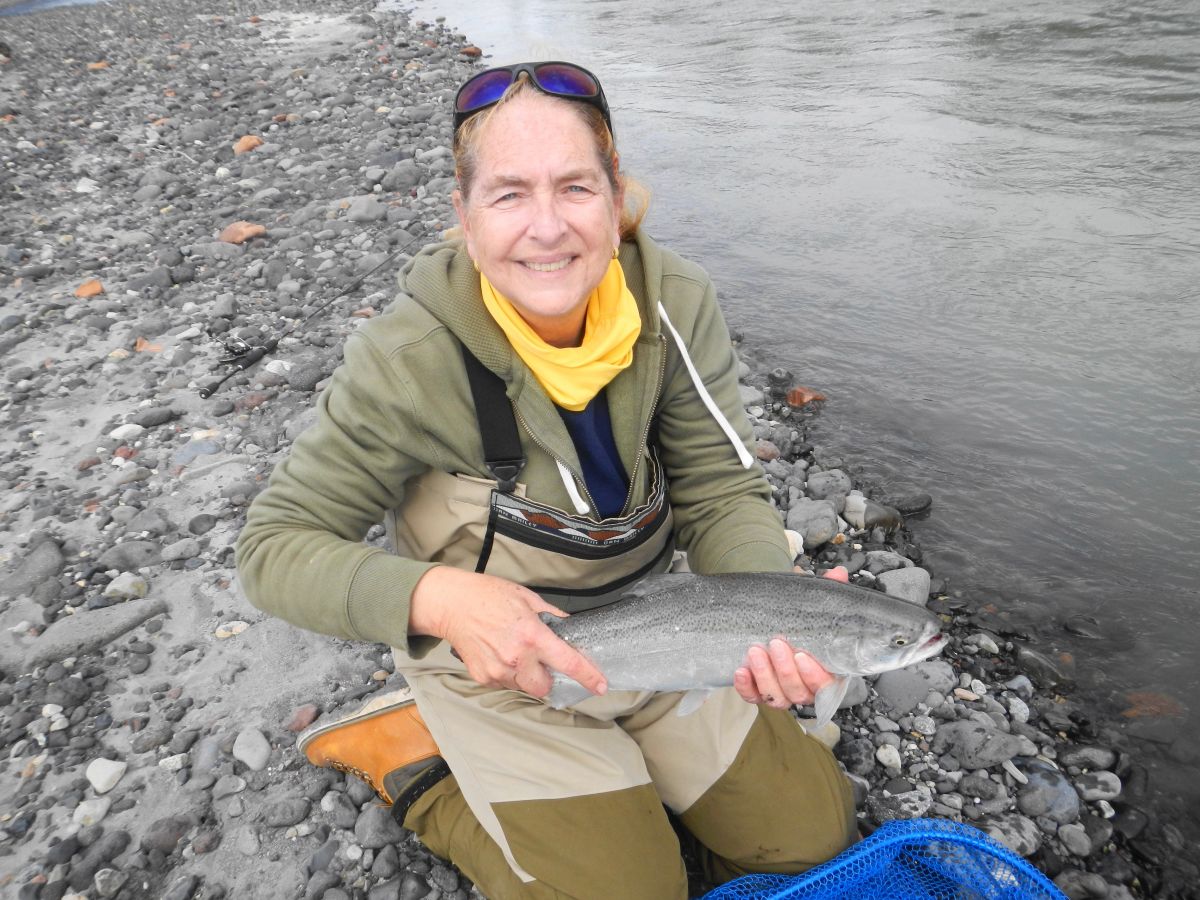
Patricio with nice Steelhead at the estuary
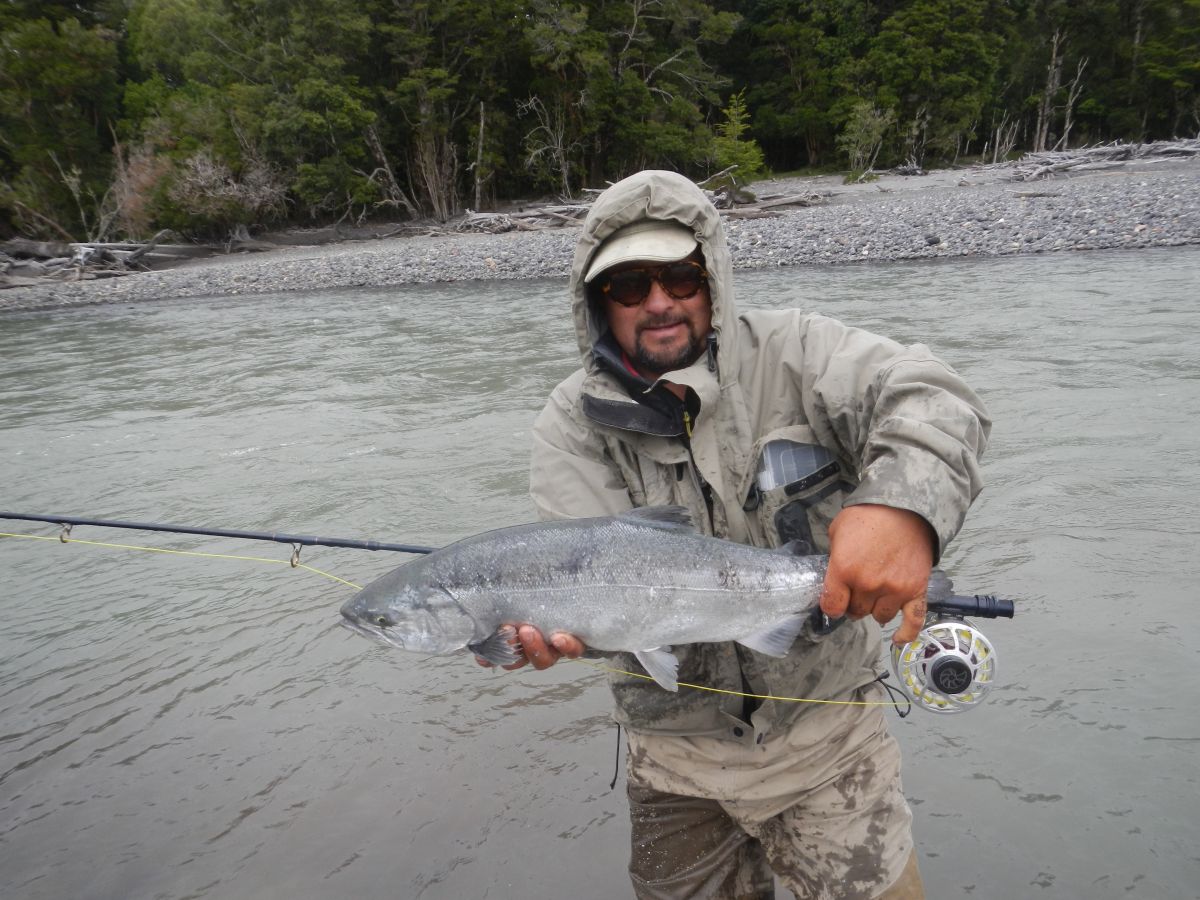
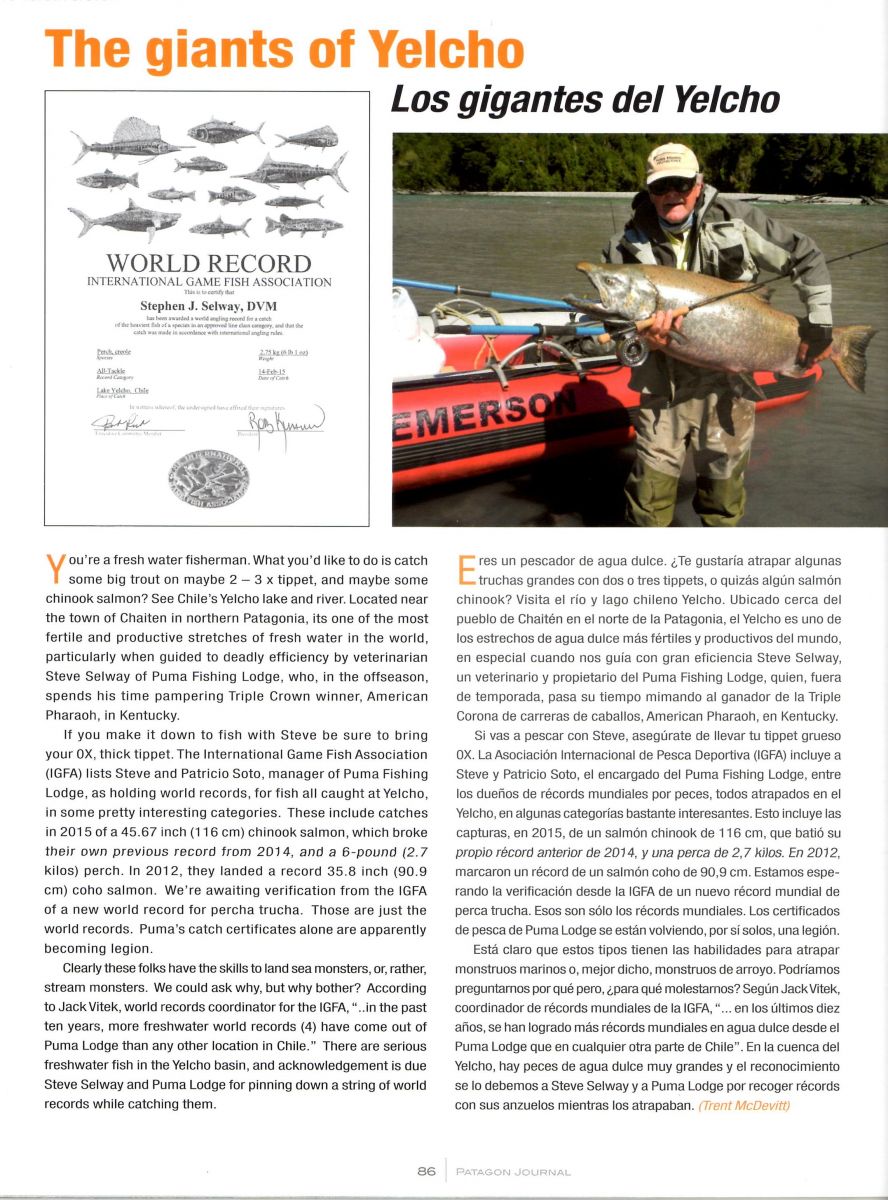 SUMMARY OF THE 14-15 SEASON
SUMMARY OF THE 14-15 SEASON
I apologize for the delay in getting the season summary on the web site and getting all sections updated. Upon arriving back in the USA it was immediately necessary to fulfill my duties as chief veterinary advisor and surgeon to the Zayat stable. I turned out to be a memorable experience as the thoroughbred, AMERICAN PHAROAH,won the Kentucky Derby, Preakness Stakes, and the Belmont Stakes. Thus he became the first Triple Crown winner in 37 years. Between those obligations, the horse sales, and my surgery case load, it was a real whirl wind. Again I apologize for the neglect of the web site but there are only so many hours in the day.
First off I brought down a large container with 5 new customized boats and Yamaha 4 strokes along with my Toyota Sequoia, power tools, hand tools and other supplies. What an ordeal to get it into our duty free zone - it only took 18,000 USD and two months AFTER the arrival of the container. Doing business in Chile can be a nightmare. It was sure worth it in the long run as all clients raved about the customized boats for both the lake and the river-I went with Tracker deepV lake models customized to have both casting platforms fore and aft (even Yeti coolers as the rowing platform). The river boats are Zebec inflatables of 18 and 18 1/2 ft which are heavily customized with bow rails, aluminum floors, pedistal seats, cooler seat with back rest, and a casting platform in front of the motor with a lean bar. The Avons were great but they were getting up in age and were small to fish two anglers at the same time. Even guides from other lodges said that we have the best boats in the Chilean Patagonia.
The season began with lower than normal water level in the watershed and less snow in the mountains. The fishing was excellent in both the lake and the river. The high light of December was 84 year old Rafael catching two trophy browns well over 5 kg using his 100+ year old Hardy bamboo rod. In Jan. we hosted a double group of HEALING WATERS/WOUNDED WARRIOR sponsors and veterans. What a wonderful time was has by all - and they have already booked for next year. Bill Potter was in charge of the group and said that he caught more fish during the week than he had caught in his last 4 trips to other places in the Argentine and Chilean Patagonia combined. It was very enjoyable working with and sharing the magic of the Yelcho with them.
From the last part of Dec. thru the first half of March we received very little rain thus the weather in our temperate rain forest became an obvious drought. Temperatures were above normal and water levels were low. This resulted in catching many smaller trout in the river except just before dark. We resorted to fishing early in the morning and in the evening with a longer siesta during the less productive hours. Our clients have always been suprised that our fishing schedule was such that we normally fished from 8 to 1 or 2 then after the large lunch would take a siesta and fish from 5 or 6 until dark (9 or 10) then supper, hot tub and do it all over again. Fishing earlier so that we had both prime time for the trout and salmon was an extra load for the staff but was necessary and quite rewarding. A fair number of clients caught a Patagonia Grand Slam of rainbow, brown and brook trout in one day. There was also the opportunity for the Patagonia Royal Grand Slam of the three trout and the native fish, Percha Trucha. Most clients caught the largest trout and Chinook salmon that they had ever caught, even quite a few of our regular, repeat clients. The drought negatively affected the Chinooks as there was no river flush and the run did not really get started until about the second and third week in Feb. - has started the first two weeks for the last 4 years. Unfortunately the salmon set out in the bay of Chaiten and the large colonies of sea lions had a feast. When the Kings did come in they seemed to travel up the river into the lake more rapidly, thus spending less time in the pools. There were some very big Chinooks in the run with our lodge manager, Patricio's current IGFA length world record being tied or surpassed several times. Unfortunately, (I would rather that a client had caught the new world record), I ended up with what the IGFA tells me is the new world record. I caught this salmon while trout fishing with a 7 wt rod and 12 lb tippet. Talk about bringing a knife to a gun fight. I was fortunately able to get the fish to the net in about 20 minutes thanks to luck and Patricio. The next day with a 12 wt. I saw a real monster come out of the water chasing somethingout of a pool. I hooked him and after 2 hours and three miles of river including 2 areas of fast water the line caught on a submerged log and I watched the hook come out of his mouth while I was freeing the line. I have never had a fish (including tarpon & big jacks) ever kick my butt so bad. He jumped 8 times and I had the leader to the end of the rod at least 30 times but we could not get this brute in the net - and our nets are very large. We figure he was at least 6-10 inches longer than the record that I caught the day before. Therefore he must have been close to 100 lbs. A real treat was that the Atlantic salmon run in the Yelcho the last half of March and the first half of April was better than we have seen in years. They weren't the size of the Atlantics we used to catch at the Rio Blanco estuary but they were real fighters.
Please look at the testimonial of John Trudinger from Australia, and Kitsi Atkinson and Tom Pool of Colorado who have fished all over the world. That pretty much sums up the season and we got two new IGFA world records and several trout and salmon that just missed and were sure true trophies. The only real down side was that the 20-40 lb rainbows and browns eluded us once again, though we saw them jump in the lake and follow in the river. I would like to thank all of our guests and my staff for making the season so great.
CHINOOK SUBMITTED AS IGFA LENGTH WORLD RECORD
Caught on 7wt and 12 lb tippet while trout fishing
PERCHA TRUCHA SUBMITTED FOR NEW IGFA WORLD RECORD
NEW CUSTOMIZED ZEBEC INFLATABLES ON BEACH AT LODGE
EDIT(1).jpg)
NEW CUSTOMIZED 16 FT TRACKER DEEP V LAKER SKIFFS
SUMMARY OF THE 13-14 SEASON
Our winter of 13 was a cold snowy one and we actually had show on the ground at the lodge a few times with one occassion being to a depth of about 4 inches.The weather was normal spring weather but the beginning of summer saw cold and often wet weather. I had never experienced this happening in January in the 30 plus years of fishing the watershed-even duing el nino and la nina years. Flowers did not bloom and the caddis, midges, dragons etc. were scarce until about the end of the first week in Feb. From then on for the next 5 weeks we had no rain at all. So the dry fly fishing in January was negatively affected and the Chinook salmon run was negatively affected because the river got very low and salmon were getting eaten by the sea lions in the bay at the mouth of the river. As a result of this crazy weather the numbers/day were down in both the lake and the river but the quality of the fish was excellent. We noted that there were more very nice Browns brought to net in both the lake and the river this season. Head guide, Mark Fuller and I hooked into the largest brown that I have ever seen on the end of a line one day. The gigantic male was either hooked in the kipe or had the fly between his teeth so he did not even acknowledge that he was hooked. We conservatively put him between 40-45 inches -- needless to say neither Mark nor I slept that night. What a true monster- I wanted to cry when the hook came out. Todd Hughes caught a real trophy Rainbow in the lake as did annual client and spey casting fanatic, Huw Llewellyn -- both the largest Rainbows that they have ever caught. Several browns were taken in the 8-12 lb range. Everyone had a real blast site fishing to cruising trout in the lake when the lake got low when we had all of those weeks of no rain. We brought to net several salmon though not as many as last season. Patricio Soto Ocampo and I both caught IGFA world record length Chinook salmon -- the nod goes to Patricio - congradulations! Now PUMA FISHING holds both the Chinook and Coho length world records. We did have the hook break on a gigantic Chinook after a 45 minute fight that would have made the new world record Chinooks look small-what a shame.
We were fortunate to have guide Mark Fuller return and first year guide, Zack Lazzari, was a real asset especially with his expertise in lake fly fishing. They are both great guys and the clients loved them. Both will be coming back next year. We did have a booth at the Mass, NJ, WA and CA fly fishing shows -- the latter two handled by long time client Steve Shahinian - thanks Steve. I would also like to thank ALL of our clients from last year - almost all of them have already booked for the 2014-15 season. I will be getting photos up between doctors appointments to see if they can fix the hip before the coming season. Zach and Mark are going to help me with some video editing and we will add that to the web site and to facebook. We are also looking into upgrading some of the skiffs for this next season. Will keep you informed.
PATRICIO'S IGFA LENGTH WORLD RECORD CHINOOK
THE OTHER LENGTH WORLD RECORD WITH DR TOM TRIBOLET
SUMMARY OF THE 12-13 SEASON
The fishing both in the lake and the river was very good in Dec. and Jan. although we had considerable rain during most of Dec. thru the first week in Jan. which was quite unusual-- a wet, cool spring.The first part of Feb. was also plagued by two fronts coming thru.
The dry fly fishing in the lake was very good when we had sun and no rain for a few days - so it was good most of Jan. and most of Feb. with 3 of the monsters hooked and fought but they were not able to find their way into the net for a photo op.
The Chinook run was even bigger that last year. To give you some idea of the quality of the run 89 were landed in just a three week period. One client, who is an excellent fly fisher, had just taken up spey casting and when he arrived he said "I would sure like to catch one of the Chinooks with the spey casting" -- he landed 11 in 3 days.
In conclusion, we cannot control the weather and we certainlu did have a wet spring and about a 10 day period the first part of Feb. which did make the dry fly fishing difficult for a few clients. However, those that would adapt to the conditions at hand had a very enjoyable trip. An example of this is a client that switched to a wet fly in the lake and caught 26 of those qualityYelcho Lake trout in one day, while the same day those that did not want to fish anything but dries did not fair near as well. This illustrates the diversity of our watershed and fishing waters.
I want to thank all of our clients and am pleased to announce that all but three anglers have booked for next season.
Here is a nice Chinook caught by a lady angler but the next photo shows that her husband's was bigger.
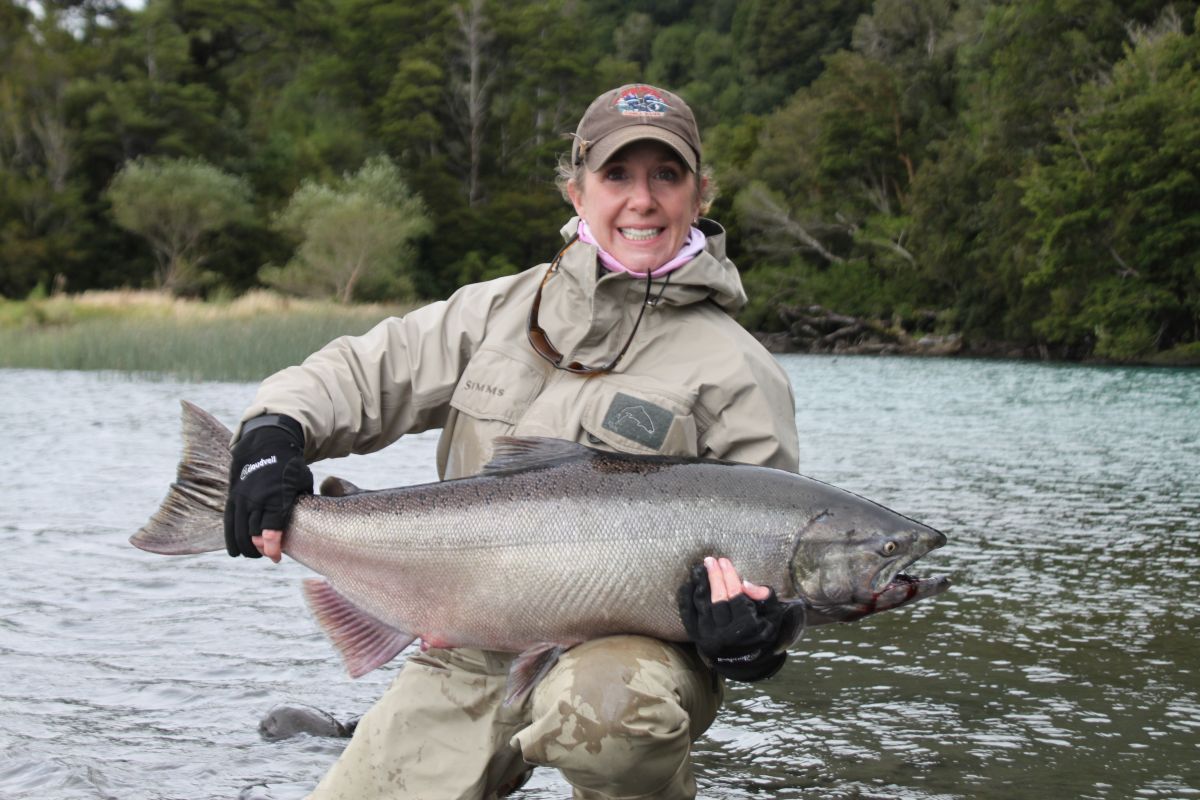
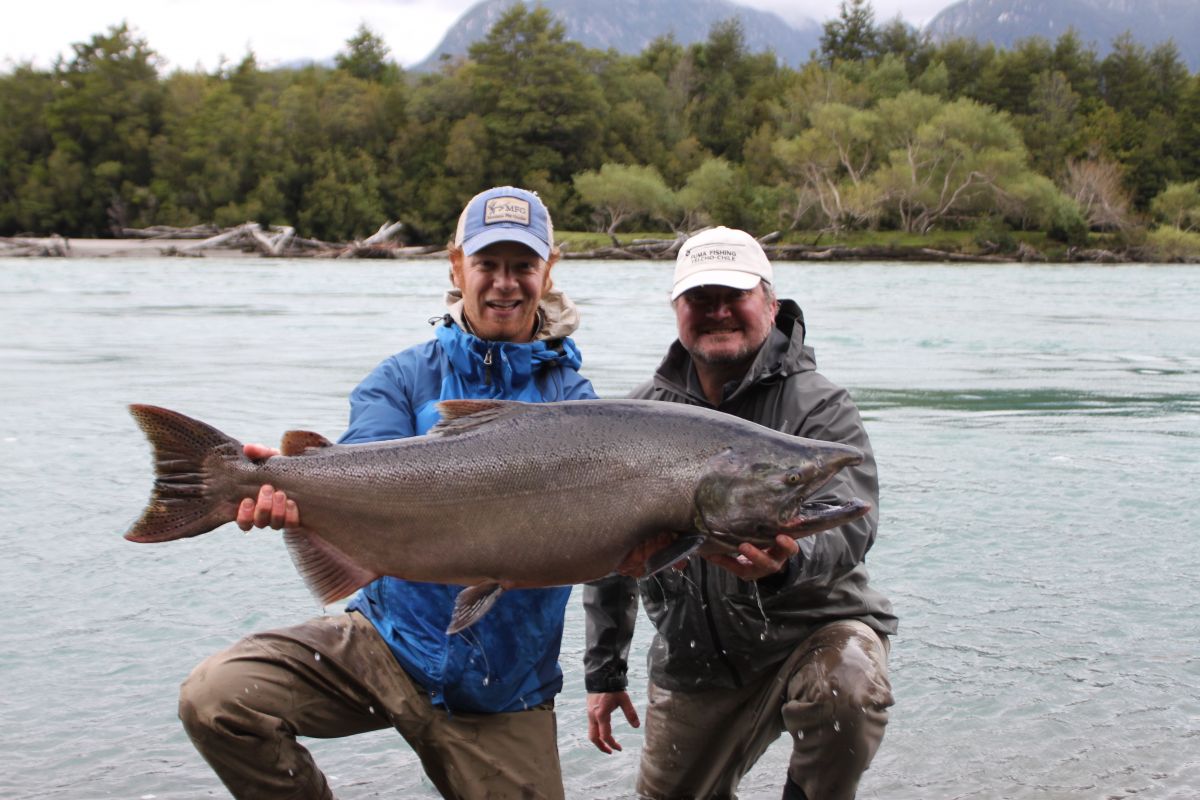
SUMMARY OF THE 11-12 SEASON
The season opened with excellent trout fishing both in the lake and the river. The spring Chinook run was the largest that we have ever had.
The last week in December marked the beginning of over 7 weeks of no rain and unusually hot temperatures with several days reaching into the mid to high 80's. The fishing in the river began to be negatively impacted (especially the size of trout) and the best fishing was in the early mornings and in the evenings. During the last few weeks of this hot, dry period we also fished more early mornings and evenings in the lake --again with greater sucess. But the sucess equaled excellent dry fly fishing; so it was worth it.
During the second week of February the weather turned cooler than normal with significant rain and wind. This abnormal weather lasted through the forst week in March. The long range forecast for the rest of March was for no rain and warmer weather. I guess Chile is not being exempt from the uncharacteristic weather extremes that have been taking place all over the world. At least February's weather was more typical of April.
These highly abnormal weather patterns (which which were not related to an "el nino" or "la nina") did produce an interesting phenominm regarding fishing in Lago Yelcho. Our observations led us to the following explaination, which although not supported by scientific fact; explains what we observed during the second and third weeks in February. The fishing in the lake was uniformly slower than we have ever seen in the last 25 years of fishing these waters regarding both the dry and wet fly fishing. The fish that were being caught had markedly distended abdomens and prolapsed rectums. Palpation revealed that the distention was the result of accumulation of snail shells in the trout's digestive tract. Therefore we postulated that with the unusually long, hot , dry spell that the trout stronly keyed into the abundant supply of flying insects, (dragon flies, damsels, stones, midges and caddis) and for this 7 week period the trout ignored one of their main food sources -- the snails.
When the weather changed abruptly they began to pig out on the snails but not having the ability to crush the shells they had to pass them thru their digestive systems and became snail shell constipated or impacted. Thus they went off feed and became lethargic until they got rid of the shells. This lasted about 10 days before everything went back to "normal". I believe that this happens to some degree all the time, but the unusual 7 weeks of dry, hot weather followed by the abrupt change to cooler, wet weather amplified this phenomina.
No monster rainbows or browns were brought to net this season although some were hooked all season long. Several double digit rainbows and browns were caught with actually more browns this year rather than rainbows. Again this season most of our clients caught the largest rainbow and/or brown that they had ever brought to net or had done so on previous trips to our lodge.
One of the most gratifying moments was when a client that had never cast a fly line was given some casting lessons and went out that afternoon and caught several trout on the river on both dry flies and on streamers -- needless to say he has already booked for next season.
The fall salmon run started a week or two earlier than normal (probably due to the cooler, wet weather in February) and was very good. I was fortunate to catch a world record length Coho (silver) salmon in February. This magnificent fish jumped three times like a tarpon and was 92 cm in length. We have not caught many Coho during the last ten years so were pleasantly surprised to have made his acquaintance and to get an IGFA world record. I also caught a Chinook that was a world record in the length category for a few weeksduring 2012. She was very thick and weighed about 70 lb. and was 107 cm. in length.
The trekking trails to Pumalin Park, who's south enterance is adjacent to the lodge again proved popular as non fishing activities as well as the trek to the Yelcho glacier.
Unfortunately we were negatively affected (like most international fishing lodges by the state of the world economy -- particularily the USA's. We continue to receive more Argentine clients which is interesting. Hopefully the economy will improve for next season and we will be fully booked and have less cancellations.
I would like to thank all of the clients that we had the pleasure to entertain this season and hope to see them all back next season.
SUMMARY OF THE 10-11 SEASON
I had planned on doing up dates every two weeks since I was going to be present for most of the season but my computer crashed the second week that I was in Chile -- so had to wait until I returned to the USA. So you are getting it all at once and I am long winded as usual but I want you to get the true picture of the season.
The season was plagued by cancellations (as most lodges were) due to the depressed world economy -- however fishing quality was phenomenal with several clients bringing to net their best fish of a lifetime including two world record weight Rainbows that were caught on dry flies.
The season started off with good fishing at the upper end of the lake with longtime client Jorge Hurtado and friends. The first of December we were honored with the return of legendary saltwater guide, Capt. Bill Curtis and world renowned fishing photographer/author, Pat Ford. Capt. Curtis, who is 87 years young, broke his hip last year and was unable to make it down but made up for it this year. Pat Ford was unable to schedule for Jan., which I felt would be better for his photography since we would most likely be having the first phase of "la nina" as we had the "el nino last year. Unfortunately I was right as the weather was unseasonably cold and wet. The fishing was uncharacteristically slow for this time of year (the fishing was the best that we have ever experienced during this time last year), but Pat still managed a Rainbow over 10 lb. on the dry and Rainbows of 12+ and 16+ lbs on streamers. Pat took many amazing photos, had Mac books made for us and has written articles on his trip (including SOL y MAR internet magazine), as well as adding a chapter in his new book that will be out this year. The most memorable photo sequence was in the Bay of Lions when Capt. Curtis fell out of the boat into the lake -- Bill did not loose his hat, glasses, false teeth, or his rod and true to his reputation when they got him back in the boat he landed the fish. The river was as slow as I have ever seen it for Dec. and did not get back to its normal self until mid Jan. -- but when it did it was fabulous, especially for numbers; with50-100 fish days/angler not uncommon. With the crazy weather and dramatic changes in weather every few days the flies and mosquitoes, which usually are only around for 3-4 weeks were instead present for over 6 weeks.
We celebrated New Years on PUMA II with the John Sikura group, including a roasted turkey dinner and champagne which was nice especially since this was John's 5 visit to PF. John hooked some very large Browns in the lake and did very well in the river as well. I did have a magical but heart breaking day on Jan 2 when I had the hook break on a huge RB that we had been watching jump several times at the Bay of Lions. The fly was new but could not handle the force of me trying to stop the fish from getting into some trees that jut out into the bay. We estimated the fish to be between 36-40 inches and weigh over 35 lbs.. That same day we saw the largest trout that Patricio and I have ever seen, feeding but could not get him to eat. This monster Brown begin feeding again after the sun went down and we were there waiting for him. On the second cast he ate but he thru my extended body green drake in a matter of seconds. Both Patricio and I felt that he was between 40-45 inches and very thick so he was well over 40 lb. -- probably closer to 50 lb. What a fish! I did manage to catch a 23+ lb. RB on a streamer the day John Sikura left and lost two other monsters. We had the pleasure of fishing Chuck Moos from Minnesota the second week in Jan.. The weather was horrible and the fishing slow but Chuck is an excellent fisherman and was rewarded by bringing to net a 13+ lb. RB on the dry. Hopefully when he brings down a group next season the weather Gods will make up for his trip this year as he is one of the most enjoyable anglers that I have ever fished with.
My bad luck /poor fishing skills continued as I lost 3 other very large, world record class fish in Feb. including one that spooled me (actually he went over 3/4 into my backing to where the backing got caught on itself); and a monster that took the wet fly right at the boat and when she came up she was so close that I could have touched her. The hook came out after a lengthy battle. The three of us in the skiff independently estimated her length to be between 42-45 inches, so well over 40 lb. I also lost a monster brown in the river one evening while fishing the logs close to the lodge.
The fishing Gods were also very kind to me as I brought to net an 18+ RB on a wet fly and one magical afternoon in lat Feb. two potential world record RBs -- a 34.8 lb monster and a 29.9 lb monster BOTH ON THE DRY FLY! Actually the same fly caught both of these magnificent fish - a #6 black winged, bullet head salmon fly. I am humbly grateful that I caught these two fish but at the same time wish that one of my clients had been on the end of the rod on at least one of the fish. Also it would have been great to have had the hook up on video-though we did get most of the fight and the netting. Due to procedural problems and misinformation that I had as to the IGFA records for the tippet classes ( a friend had looked up the records for me before I went down but unfortunately looked at the all tackle fresh water line class section rather than the fly rod tippet class section. The procedural problem was that the certified scale certification had expired. Oh well, these magnificent fish were released in good shape and I hooked 4 RBs and 1 BR that were larger so hopefully our clients can establish new records with these fish next season. AND THESE FISH ARE NOT THE GENETICALLY ALTERED TRIPLOID HATCHERY FISH THAT PEOPLE HAVE BEEN SETTING THE RECORDS WITH IN THE ALL TACKLE LINE CLASSES FROM LAKE DIEFENBAKER IN SASKATCHEWAN, CANADA. From what I hear those genetic freaks don't take the fly very well - especially the dry fly as is evidenced by no records in the IGFA fly rod section.
Our clients in Feb. from Ireland, Argentina, Chile and the USA did very well with all of them catching the largest trout that they ever had. We are getting more Argentine clients as they have heard of the quality of fish that we are catching and know that unless they go to Jurassic lake or down to Terra del Fuego for the sea run browns that they can not have an opportunity to catch this quality of trout. I did note that there were also lodges further south in Chile that were coming to fish our waters for these quality trout as they did last season.
We still do not know why we are catching these gigantic trout as we have been fishing these waters for about 25 years and other than the occasional monster of over 20 lb. we have generally caught fish that we considered trophies in the 10-20 lb. range with the majority of the trophy fish in the 10-15 lb. range. Patricio has came up with a possible reason: When the Chaiten Volcano erupted we received very little ash (a couple of inches at most), however the prevailing winds carried the ash to the SW and deposited 12-18 inches of ash in the Futaleufu area of Chile and the Esquel area of Argentina. Since the Futaleufu River is one of the main rivers flowing into Lake Yelcho a lot of ash was washed back into the lake. With the electronics on PUMA II, (that were required by the Chilean Navy) we have noted very large fish at depths of 60-200 meters. Therefore is it possible that some of these very large trout have been displaced by the ash into shallower waters and due to the food supply and rich environment that they decided to stay? Who knows? But it is an interesting observation and possible explanation.
The Chinook salmon were about 1-2 weeks later this Feb. (probably because of the "la nina" weather) but the run has been strong although not quite as big as last season. I was told by Jack Smith, who lives where the Michimahuida River runs into the Yelcho River that he weighed a Chinook on his scale that was the largest that he had ever seen last season -- 83 lbs. The largest that we have caught was 65+ lb.. Most of our Chinooks this year were in the 30-50 lb range. As usual, the longer the salmon are in the river the harder they are to catch on the fly. Spin fishing being much more productive.
Fortunately we have both Chilean and Argentine groups booked for April so we will see how the Brown pre-spawn fishing is, as well as the tail end of the Chinooks. The second half of the "la nina" has stayed around so the weather has been warmer and drier than normal. This has resulted in some very good dry fly fishing in the lake and the river, especially for March. The river fishing, which started slow this season, has been every good to exceptional since last half of Feb..
NEW SKIFF FOR PUMA II UPDATE:
The skiff to accompany PUMA II, that Patricio and I designed and had built after the end of the season last year was a real pleasure to fish out of with its casting platforms for and aft. Our clients gave the boat rave reviews and we will replace the remaining wooden Chilean skiffs when indicated with this type of boat.
DAPPING:
This season I went down with a 17 ft 3 in dapping rod given to me by long time client Dr. Paul Thorpe. He thought that dapping might be effective on windy days in the lake. After reading articles and books on this ancient fly fishing technique as well as discussing dapping with friends and acquaintances in Europe I decided to give it a try. If it is effective, I might be able to use it as a "locator" of trout that "were looking up". Boy, was it ever effective! Even during the first part of the "la nina" when there were few fish rising (if any), they went crazy for the dapping fly bouncing on the water surface and gliding just above the water from one "landing " to the next. In fact it was so effective that I broke the hook off, and had a client stand beside me and cast to the trout that rose to the dapping fly=extremely effective. This technique was also exceptional for those clients that were novice fly casters as well as the seasoned angler when fishing was slow or it was quite windy.
Since we had so many cancellations this season we put the time to good use --in fact I actually did very little fishing this season. It was necessary to rebuild the road to the river. This took us over a month and a lot of back breaking work as all we have are hand tools, the oxen and our pickup. One area alone had to be built up over 2 ft. for about 100 yards -- that is a lot of rocks being hand picked and placed on the road bed. After we got the road bed and drainage areas set we top dressed the road with 5 large dump trucks of gravel. The second project was a chicken coup and chickens --the eggs sure are better than store bought. The third major undertaking was to clear land and build a nice greenhouse so that we can raise our own tomatoes, lettuce, and herbs for our chefs. We have also cleared land (except for stump removal) to build another greenhouse next year and a garden for carrots, potatoes, etc. The last major project was to build a patio (out of flat rocks from the river), across the back of the lodge and paths to the cabanas, maintenance area, and generator and well locations. Patricio and Adier had already built an addition to the maintenance building and a covered structure adjacent to the maintenance building for wood storage. We believe that these projects will help us to provide our clients with the highest level of service -- so, although the work sure decreased the time to go fishing, it certainly was worth it. And I even lost over 35 lbs. as an added benefit.
YELCHO AREA UPDATES THAT WILL AFFECT PF:
In Jan. the government decided that with so many people moving back into Chaiten that they would allow the northern half of the town to be rebuilt and would restore water, sewer and electricity. The people were very happy and everyone worked very hard to get the town ready to "live" again. By the end of Feb. electricity was restored and a 3 day fiesta celebrated the rebirth of Chaiten.
The government is also widening and preparing the road from Chaiten, north to the new airport at Santa Barbara to be paved. They are also doing the same from just south of Amarillo, where the pavement ends all the way to Lake Yelcho at Puerto Cardinas. I hope that they finish it next year because the roads have been very bad - especially with the construction - and they are literally destroying our vehicles. Hopefully this work will be finished by next fall.
We are also eagerly awaiting the opening of the new gas station and nice store in Amarillo that Mr. Douglas Tompkins is building. Since Amarillo is very close to the lodge we will not have to go to Chaiten as often.
We have been told that a new cell tower is planned for Amarillo. We hope to be able to receive the signal so that we will have telephone service at the lodge. If this does not come to pass, we are also exploring our options for a satellite connection that will be more practical than the one that we used to have.
DOUGLAS TOMPKINS- PUMALIN PARK UPDATE:
Douglas Tompkins, owner of the world famous eco park, PARQUE PUMALIN, and I have been trying to get together for over 2 years. We finally were able to enjoy lunch with him and some of his friends at our lodge. During our afternoon conversation I found Mr. Tompkins to have the preservation of the Chilean Patagonia, which we both have fallen in love with; as his foremost goal while at the same time helping the local inhabitants thru education and employment. His vision is to make Amarillo, the small town next to our lodge and the south entrance to PARQUE PUMALIN, a showcase for what this area can be -- and probably with his determination -- will be. He has transformed the small town dramatically, and for the better; by helping the local inhabitants fix up their properties and he is near completion of a gas station and large store as noted above. Also he has been instrumental in the formation of a new national park just south of the Bay of Chaiten. I believe it will be called Corcovado, after a beautiful, old volcano in the area.
Some people in Chile do not like him because of his outspoken views on practices detrimental to the environment in our area, such as the salmon aquaculture practices, logging, and proposed dam building further south. But I believe that he has the best interest of the country and its people at heart AND is putting his money where his mouth is as well as being one of the largest if not the largest employers in the region. His voice is certainly the balance that is needed so that "progress" in the area does not go unchecked and destroy this unique, fragile ecosystem by trying to make it an area of more intense agriculture and/or strip its natural resources. I imagine that some of my friends and family in Montana are surprised to hear me say things like this, as I have been outspoken about government and "tree hugging" environmentalists interfering with the lives of those trying to make a living in Montana. However, I believe that this area is completely different geographically, is very sparsely populated, is more fragile than SW Montana and that tourism is the only logical answer for the economy and sustainable existence of this region. I know that some of my Chilean friends do not see Mr. Tompkins that way but I believe that they will eventually realize that for the most part that they are on the same side on the basic points. I do realize that Chile, including the Patagonia needs to progress and meet its necessary obligations to the people but it must be thought out very carefully as to how to meet these obligations without destroying the goose that laid the golden egg. As long as a rational balance is achieved I believe we will be okay.
The numbers of people coming from all over the world to visit PUMALIN PARK this season was very impressive. Pablo was responsible for taking our clients to the park as a non-fishing activity and the overwhelming positive feed back was amazing. The photos and stories that these clients shared regarding this experience was like an angler catching a true trophy trout. Tompkins has done an amazing job with this park and we encourage out clients to consider taking the time to enjoy this gem with its fine trekking trails to glaciers, lakes, waterfalls, the magnificent Alerce trees, and even the Chaiten Volcano.
DIDYMO (ROCK SNOT ALGAE) UPDATE:
The didymo bloom that was found in the Futaleufu River and its tributary the Espolon River last year in May and June has fortunately not been a problem for us. We had instituted a policy of requiring clients to disinfect their waders and leave their wading boots at home in 2008-2009. We purchased wading boots for use by our clients so we were ahead of this possibility of invasion of unwanted species as best we could be. Patricio has worked with the government officials since the infestation was discovered as to monitoring the waters that we fish. We also have instituted a cleaning and disinfecting protocols for our anglers' and PF's exposed equipment when fishing the rivers. In Dec. we found a very small area of infestation on a beach on the Yelcho River that was accessible to anglers from the main road (Carretera Austral) . We found that this area did not expand and in fact was completely gone in less than 30 days. We have not found any other sites with didymo nor recurrence at the site on the beach for the last two months. We therefore consider the Yelcho River to be didymo free at this time. This we are very thankful for and it is certainly a far cry from the assumptions and predictions of some people including lodge owners further south who's dissemination of inaccurate information and assumptions were emailed around the fly fishing world as a gloom and doom scenario for the Yelcho watershed. One wonders if this was an honest knee jerk (panic) reaction or an attempt to black ball the Yelcho watershed in hopes of moving client bookings to other areas -- I certainly hope not! At any rate it looks like we have been spared - at least for now. Unfortunately it has been reported tht the didymo has surfaced in the Coihaique area. I have not been down there to see for myself just how extensive the out break is so cannot and will not comment on it -- like some people did last year. We do have our spread prevention measures in effect and will continue them as well as monitoring our waters closely. As usual the government has been very slow to react and pick up the reins as to educating all outdoor enthusiasts (tourists and locals). Therefore it has been up to the lodges in the area to do this for the most part. We will continue to do our part.
MARKETING:
Castafly Travel, the new booking agent out of Montana, will be booking for us. We believe that this quality group will soon be one of the major bookers in the world and are happy to be associated with them. Tim Tollett's Frontier Anglers will remain a booking agent as well. We also are nearing agreement with Chile's Rod &Gun (Patagonianation.com) as well as possibly another booking agent in Chile and a booking agent that has handled primarily the Argentine Patagonia but wants to enter the Chilean Patagonia. Guillermo O'Reilly (a longtime client and retired Dole Chemical executive) has joined us and will be involved in marketing and management in Chile. OF COURSE, WE WILL CONTINUE TO DO DIRECT BOOKINGS AS WELL. As those that subscribe to THE ANGLING REPORT know, our new brochure was sent to all of their subscribers in their Jan. issue.
The above marketing efforts, as well as , all of the exposure that Pat Ford has provided; appears to be paying off; and the monster trout that PF has been bring to net sure has not hurt either. As a result inquiries and bookings are up significantly and hopefully we will be pretty much booked full well before the start of the season in spite of the slow recovery of the world economy. So don't get shut out of your desired dates! We do not know how many more seasons these monster trout will be available. We have taken care of them as best we can before releasing them and all appeared in good shape but there may be some mortality and we have heard that some of these fish have not been released and/or could not be revived. This is a shame and we have urged all guides and lodges to take special care of these fish -- only time will tell.
Even though the USD has lost 1/3 of its value in Chile in the last 2 years, we decided to bite the bullet and keep our rates the same as they have been for the last 3 years.
We would like to thank all of our clients that were our guests for this season. I apologize for length of this summary.
34.8 lb. RAINBOW CAUGHT ON DRY FLY
%20edit%20w%20date.JPG)
29.9 lb. RAINBOW CAUGHT ON DRY FLY
(was caught the same afternoon, with the same fly as the 34.8 lb.
monster and this fish was also longer but not as heavy)
23+ lb. RAINBOW ON WET FLY
SUMMARY OF THE 09-10 SEASON
I went down to host the first two abbreviated groups (one group of 5 and the other of 3) from the last week in Nov. - thru the first two weeks of Dec.. Unfortunately El Nino was affecting the area this year as the weather was cold, rainy and windy the first week -- in fact it had been raining since the middle of August. The lake was about 10 feet above its normal level for that time of year. There was no dry fly fishing until the last two days that I was there but the fishing was beyond normal comprehension as we have never caught the number of big fish like brought to the net during this period -- 19 trout over 10 lb.; 6 between 15 - 20 lb.; one Rainbow that was conservatively estimated to be over 24 lb.; one 28 lb. Chinook (that tasted very good); and several Atlantic Salmon. We fished the lake like we do in the fall with wet flys and the action was nonstop. The other lodge that was open caught several large Rainbows as well. Maybe we hit it just right for the prespawn of the Rainbows, or Patricio thought that possibly the ash that flowed back into the lake (from the Futaluefu etc.) may have made the monsters move up into shallower water, or all of the rain had something to do with it. At any rate, it was the most amazing fishing that I and my staff have ever experienced and we have fished these waters for many years. The last two days the fish finally started looking up and the dry fly fishing was just as spectacular as the wet fly as I caught several double digit fish and the action was nonstop-- too bad the clients had already left and the next group had not arrived yet. The Yelcho River also fished very well during this period especially from just below the lodge up to the lake.
Our waters continued to yield superb fishing the rest of the season with several of the big trophy Rainbows brought to net although not quite at the frequency noted above. The river fished very well from the lodge up to the lake. The lower portion of the Yelcho and the Futaluefu River fished excellent when there had been no recent rain but these waters did carry some residual ash when it rained and at those times did not fish as well.
The second Chinook run was the largest that we had ever witnessed on the Yelcho and the spring run had also been well above average . As usual, they took the fly better when they first came into the river and were more difficult to get to take a fly the longer and the higher that they went up the river -- at least it seemed so to us. In total 32 Chinooks were landed with most being in the 30 -40 lb range although a few were over 50 lb.. We have never offered Chinook as a target species but have noted that there seems to be more and more every year so if this trend continues we may have to rethink this.
The estuary that we travel to by horseback finally became fishable in March and April. This is the first that we have been able to fish it since the Chaiten Volcano erupted almost two years ago. The Steelheads and Atlantics were there as well as quite a few Chinooks. The Chinooks were more abundant in March. It is good to have these waters back as they had been unfishable because of a tributary to this river that originates from near the volcano making the river very off color.
The new airport at Santa Barbara (about 5 miles north of Chaiten) worked very well and AEROCORD's twin otters were full to capacity almost all the time. I met with this company after the season and they will be offering the same service next year with their schedule coordinated with the flights from the USA into Santiago with connections to Puerto Montt. The cost of this portion of the trip was about 100 USD each way (including transfer) which is much less than we have had to pay in many years -- when we had to fly into Alto Palena on other airplanes it got as high as 2,500 for a plane that handles 6 passengers. Also by offering to purchase the tickets for the Santiago/Puerto Montt travel in Chile we were able to cut that expense from about 570 USD down to about 150 USD -- these tickets are nonrefundable. Therefore saving each client almost 1,000 USD in total airfare as compared with air travel the last several years. My good friend Victor Munoz meets the clients upon clearing customs in Santiago and escorts them to the national LAN counter and gives them their ticket. In Puerto Montt Paula meets the clients and transfers them from the Tepual airport to the regional airport used by AEROCORD. They both did a superb job for us and all clients arrived happy and unstressed in Santa Barbara. Of course, if one wishes to use frequent flyer miles (AA/LAN) they can book all the way to Puerto Montt -- but those not using miles usually had us buy the tickets and reimbursed us for that segment and the Puerto Montt/ Santa Barbara segment and the transfers.
Patricio and the boys are busy closing up and making necessary maintenance and repairs for next season. We are also having a new custom built fly fishing skiff built this winter in Puerto Montt out of the strong plastic-like material that is used to make the very durable boats used in the salmon farming businesses. This skiff will be over 19 1/2 ft long and have two elivated casting platforms each with lean bars and stripping baskets. If this boat works as good as we believe that it will we will eventually replace our Chilean wooden skiffs with this type of boat when replacement is necessary.
We would like to sincerely thank all of our clients that we had the pleasure of staying with us this passed season. For the second year in a row almost all clients caught the biggest Rainbow AND Brown that they had ever caught in their lives --and the few that didn't were clients that have fished with us several times and have caught their biggest Rainbows and Browns on passed trips. Our hats are off to DR. David Nunamaker who caught the monster rainbow; to Dr Jim Peddie who caught 5 trophy rainbows in 3 days; and France Surprenamt who caught a probable world record native fish called a Peladilla-- well done! We have received considerable inquiries and have booked several groups for next year so if you are interested in booking please contact me.
Here are a few photos of the 09 -- 10 season with more put in the photo gallery (I'M SURE THAT I PUT TOO MANY PHOTOS IN THE GALLERIES, BUT THERE WERE SO MANY EXCELLENT ONES THIS YEAR) -- REMEMBER TO DOUBLE CLICK ON THE THUMBNAILS TO CHANGE TO A LARGER IMAGE/SLIDE SHOW OF THE GALLERY:
DR. DAVE NUNAMAKER AND HIS MONSTER RAINBOW
DR. JIM PEDDIE WITH ONE OF 5 TROPHY RAINBOWS THAT HE CAUGHT IN 3 DAYS!
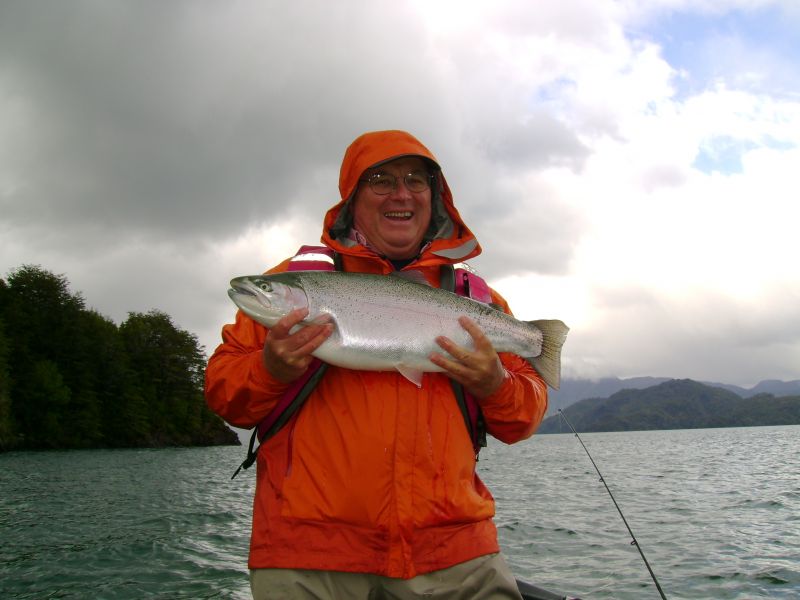
YELCHO RIVER CHINOOK -- ONE OF SEVERAL THAT AFTERNOON
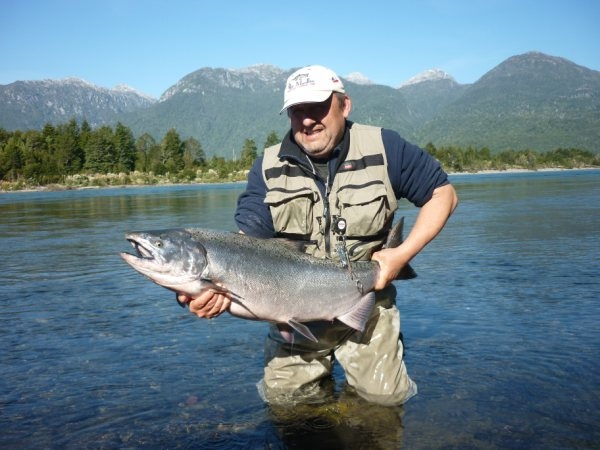
WE ARE READY FOR THE 09 - 10 SEASON
Patricio and the boys have everything ready for the season. We have an airport close by with 3 flights a week and the fish are waiting! There are a few spaces available for trips hosted by Guy Tillotson and myself in the prime dry fly fishing part of our season in Jan. and Feb. ---Please contact me for the details.
SUMMARY OF 08 - 09 SEASON
As most of you are aware, the Chaiten Volcano erupted on May 2, 08 and the secondary damage from lahars (mud, ash, and debris slides) along with the immediate post eruption rains caused the Blanco River, which runs thru Chaiten to overflow and destroy a significant amount of the town. The Negro River did the same and they both also damaged the Chaiten airport. Thankfully the residents of Chaiten including all of my employees had already been evacuated before this occurred and have had to establish homes elsewhere because the Chilean government deems Chaiten uninhabitable and has decided to move the town to a new location a few miles north, at Santa Barbara, where it will not be affected by rivers that originate near the volcano.
The volcano itself blew ash about 20 miles into the sky and, fortunately for us, most of the ash was deposited several miles to the Southeast, (in the Futaleufu area of Chile and the Esquel area of Argentina). These areas received reports of 12 to 20 inches of ash while our lodge and the waters that we fish received about 1 inch of ash. No damage was sustained at our lodge, which is two mountain ranges with valleys at right angles to those coming from the area of the volcano between us and the eruption -- we are fortunately quite safe due to this geography. We did, however; lose the Chaiten airport and had to use the airport at Palena instead. This was problematic at times when the weather was bad because this airport is situated further inland. The highway north of Chaiten was closed most of the summer due to damage where it courses near the volcano. The volcano is in Douglas Thompkins' PUMALIN PARK, which was also closed for the summer for damage repairs. The ferry service to Chaiten has continued. The volcano has quieted down and occasionally emits water vapor but no significant ash. I went down the first of December to evaluate any affect that the eruption had on our facilities and the waters that we fish (a tough job, but someone had to do it) --- see this report below.
The construction and inspection of the new mothership, PUMA II, was finally completed and it was taken from the shipyard in Puerto Montt to the mouth of the Rio Yelcho where it was then placed on a big truck and trailer by two cranes and then taken to Lago Yelcho at Puerto Cardinas -- what an expensive, complicated process. The almost year and a half past due wait was sure worth it as it turned out very nice to which Patricio is to be commended. Its maiden voyage was with the legendary salt water, shallow water guide , Captain Bill Curtis, Robert (Bobby) Jones of Glade Park Associates, Inc out of Colorado, and Guy Tillitson of Grand Slam out of Florida (the latter two associated with Templefork, Teeney, etc.). We have been having clients board PUMA II at the mouth of the Rio Futaleufu at the upper end of the lake since this is much closer to the Palena airport so it saves and hour and a half of road travel.
The lake and the rivers continued to fish fantastically all season. Unfortuanately the river estuary where we fish for Atlantics and Steelhead in March and April was not available because of discoloration from a stream that enters this river upstream and comes from near the volcano. The lower Yelcho was off color also when it rained because of the remnants of the ash being washed into the river. Both of these areas are expected to be fine next year. The high quality of the fishing was also echoed by other lodge owners that I talked to and a group that came over from fishing the Esquel, Argentina and Palena, Chile areas -- the latter party said that the Yelcho fished much better than the other locations. The largest Rainbow caught this season was just under 20 lbs and several Rainbows and Brown in the double digits as well as Chinooks to 50 lbs were brought to net. Angler honors went to Dr Miles Misohito of Hawaii who caught the largest Rainbow and largest brown. This is the first season (since I have been involved with PUMA FISHING) that every client but two caught the biggest Rainbows AND Browns that they had ever caught in their lives -- further confirming that the fishing was as good or better than it has been in the last 20 years that I have been fishing these waters.
The government has started building a new airport at Santa Barbara
but until it is finished we will have to use other airports in the area or possibly a float plane -- which I am looking into during the off season.
You are invited to join us for the 09 - 10 season which is booking well -- so don't get shut out on your desired dates! Below are a few photos of the season including PUMA II.
MONSTER RAINBOW
PUMA II AT PUERTO CARDENAS
TROPHY BROWN
TROPHY RAINBOW
UPDATE DECEMBER 17, 2008
I have just returned from my lodge on Rio Yelcho where I was able to evaluate the affect that the Chaiten volcano eruption of 5/2/08 has had on the lodge, the waters that we fish, the infrastructure of the area, and most importantly the fish in our waters.
First, the volcano still vents water vapor but of a much decreased and variable height with no significant ash production and has been like that for 4 months. The town of Chaiten and its airport have been severely damaged - not by the eruption directly, but because the Rio Blanco which originates near the volcano and that courses through the town had its river bed destroyed by mud, ash and debris (so called lahars) and subsequently the area sustained heavy seasonal rains for 3 weeks. Thus with no riverbed, about 80% of the town was severely flooded with the mud, ash and debris. Actually the amount of ash that fell in this areas was only a couple of inches because the initial eruption went about 20 miles in the air and the prevailing winds, at the time blowing towards the southeast deposited a reported depth of ash up to 12 inches in the Futaleufu area of Chile and the Esquel area of Argentina with lesser fallout all the way to the Atlantic Ocean. The airport was affected by this scenario from the Rio Blanco and also the Rio Negro (another river that originates from near the volcano). The airport runway was initially to be cleared by the end of Sept. but the government decided not to do so. The Chilean government evacuated all residents at the time of the eruption and do not want the people to move back, but rather build a new Chaiten in an adjacent area that cannot be affected by this scenario of riverbed loss and subsequent flooding. However, the former residents strongly want to return and rebuild the town at the original site. Whether the government's desire is to keep these people from moving back in or whether they felt that it had more important tasks than getting the airport open again is of some debate among the people of the area. This decision has however negatively affected the entire region, not just the immediate Chaiten area; and complicated one of the only industries that they can realize outside income from . At any rate this town of about 4,500 inhabitants remains without water and power although the former residents are allowed into the area but cannot stay on a permanent basis. So we have no airport nor comercial services at Chaiten. The government was to decide a permanent solution by Dec. but this decision has now been delayed until at least the first of the year. However the port of Chaiten is open and there is ferry service between Puerto Montt and Chaiten 3 days a week..
I arrived by this ferry as we were bringing another vehicle and supplies to the lodge. The cost of this sevrice is very reasonable being only about 30 USD, but it takes 10 hours. Sleeping cabins with 4 beds each are also available at a small aditional cost, otherwise you sit in seats similar to business class airline seats and there are meals and a snack bar as well. I went on a Friday and the following Monday was a holiday so there were over 300 former residents returning for the long weekend to work on their homes and businesses as well as trekkers and kayakers.
As of October there were to be commuter flights to three airports a bit further south (Fuateleufu, La Junta, and Alto Palena) with daily flights to one ot these three and with two flights a day on weekends. But in November flights were available only on Fridays and Saturdays and only to Alto Palena. This results in a 2-2 1/2 hour vehicle trip to the lodge rather than a less than 30 minute from the Chaiten airport. I am considering shortening the road travel by 1-1 1/2 hours by receiving clients at Puerto Piedra on the Futaleufu River at the south end of Lago Yelcho (aboard PUMA II). This of course would be logical only for those clients desiring PUMA II as part of their stay. I was told by the agent handling the commuter flights that the number of flights will be increased after the first of the year. I am going to coordinate flights with the agent in Puerto Montt and other lodges in the area so we can use these flights efficiently and avoild cancelations due to under bookings. The cost of these flights are approximately 500 USD roundtrip at this time.
The highway south from Chaiten is open and has been for about 3 months. The road north of Chaiten, which passes quite near the volcano sustained lahars damage and work on it is aggressively being done including a bridge near the volcano. This road north is projected to be open after the first of the year.
As stated before, there is little ash in our area with a thin layer on the sides of the paved road (like a skiff of light, dry snow), with the pavement ash free. The trees and grass have no ash (except in the immediate vicinity of the volcano), but there are small, thin accumulations of ash in tire tracks on the gravel portions of the road and on foot paths. The air is clean except when a vehicle travels on a gravel road or when a strong wind occurs. The white/gray ash is very fine and readily airborne. I am a rather severe asthmatic and experienced no asthma during my stay nor any eye or throat irritation. Although we have very little ash it is not like a light skiff of snow that will eventually melt but rather it remains in some areas in ground depressions and probably won't be gone completely until next year's rainy season.
PARQUE PUMALIN, Douglas Tompkin's world acclaimed eco park in which the Chaiten volcano is located is closed and will remain so until next season so they can complete a total restoration of their campsites, trek trails, etc, -- which they are working on now. Unfortunately this means we will not be able to enjoy the fantastic dry fly fishing in the lake that we fish in the park. The river estuary that we reach by horseback ride up the beach of the ocean will hopefully be of good water quality by the Atlantic and Steelhead runs in Feb. and Mar..
Construction and the brand new PUMA II mothership/floating lodge has finally been completed and the boat is being inspected and commissioned by the navy. Its considerable delay in completion has been very frustrating but the final results is quite spectacular. We were going to bring it up the Rio Negro to where this river is adjacent to the highway but since that river and its mouth were severly impacted we are going to put it on a truck and trailer near the mouth of Rio Yelcho and take it to Puerto Cardinas at the north end od Lago Yelcho. Plans have been finalized for this to be done in Jan..
The land lodge and all of the equipment I found to be unaffected by the eruption, to be in good order and ready to go. There will only be PUMA FISHING and possibly only one or two other lodges open in our area this season so it will be like when I first fished the area about 20 years ago. We needed to check the waters that we fish and the quality of the fishing found post eruption -- a tough job but someone needed to do it. The waters were in very good shape and the weather Gods were smiling although it was a bit warm for this time of year. The fishing both in Lago Yelcho and Rio Yelcho was probably as good as I have ever experienced. For example, I brought to net in the Bay of Lions 18 fish in a half day (up to 8 lbs)and all on dry flies. Captain Patricio and had similar sucess. I have never caught that many fish in the Bay of Lions even with a full day of fishing the bay. The north end of the lake produced about 20-25 nice fish apiece per day as well, on drys and nymphs with a few of the legendary "monsters" escaping having their photos taken due to bad fishing luck and probably more accurately -- angler error. The river fished as good as I have ever experienced the two days we fished it. The numbers of fish brought to net was embarrassing -- without going into detail, in one morning alone I caught 67 fish as per guide Juan Pablo's count and the evening fishing was almost as good. The fish were in good shape, fought well and showed no negative affects from the eruption. Overall I had the best fishing that I have experienced in almost 20 years of fishing these waters.
In summary, the waters we fish and the fish in them do not appear to have been negatively affected by the Chaiten volcano eruption. The infrastructure of the area unfortunately has not faired as well, particularly the town of Chaiten and its airport. The only waters that I did not fish were the upper (south) end of the lake, Rio Futaleufu, and the lake in PUMALIN PARK . The estuary that we fish for Atlantics and Steelhead was quite turbid (probably due to the warm weather - glacial melt, and because a small stream from the area of the volcano comes into this river upstream. We expect it to be in better shape by Feb. and March for the runs. The travel to/from our lodge and Puerto Montt maybe a bit of a nuisance but at least we have travel options so as to hopefully accommodate client schedules. The ash was really not a factor for health concerns but rather a short duration, transitory nuisance. I am more concerned of its affecting flights if a wind really gets strong -- which would be unlikely until April and we should be getting some rain then which will also help prevent ash from getting airborne.
Although Patricio and I traveled to the base of the volcano, no roasting of hot dogs nor marshmallows are allowed but you can take an obsidian souvenir home as the old dome of the volcano was comprised of obsidian and there is a lot of it at the base of the volcano along the road that is being repaired. In all seriousness we are very thankful and fortunate that my lodges are okay, our waters and fish are okay and most importantly my staff are okay though they have all lost their homes. So come fish the Yelcho area, enjoy this magnificently beautiful region of mountains, fjords, lakes, rivers, waterfalls, and yes volcanos -- one of which erupted 8 months ago and is going back to sleep, hopefully for another 8-9 thousand years.
Here are some photos from the trip:
FERRY
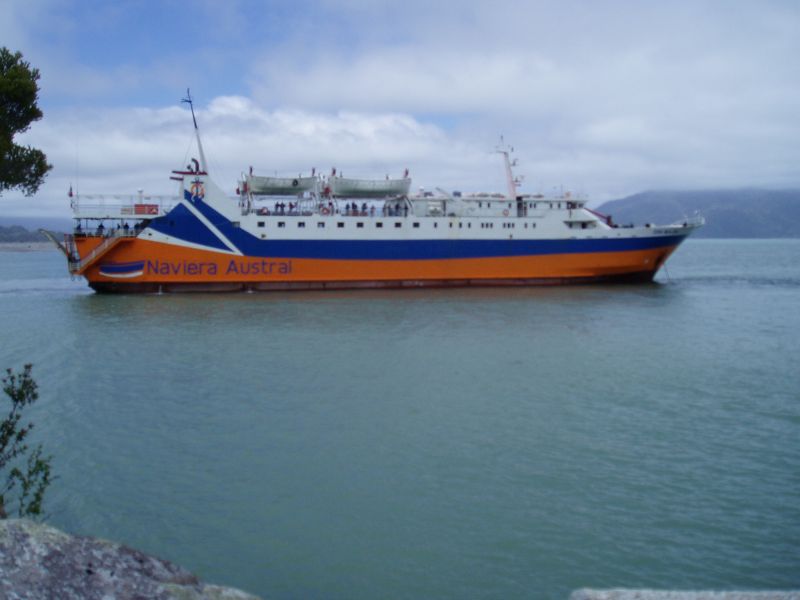
CHAITEN VOLCANO
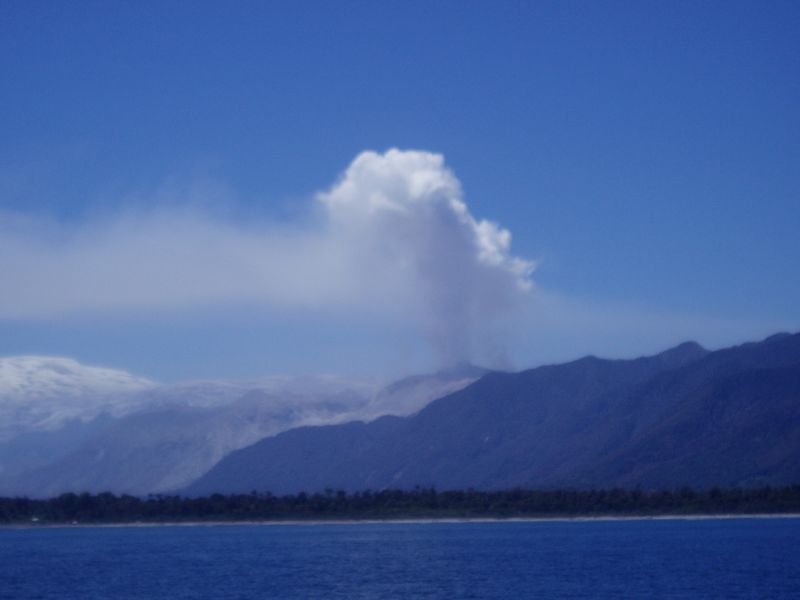
NEAR VOLCANO BASE
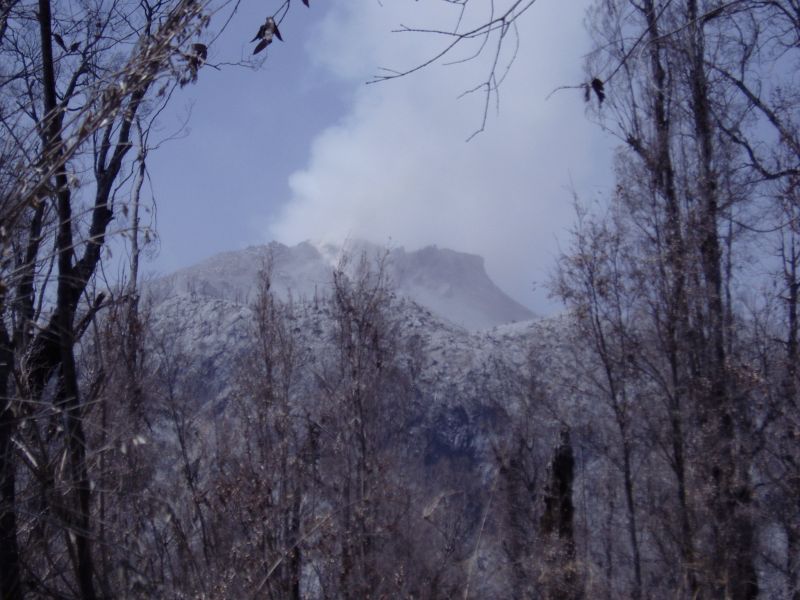
CLEAN WATER AND VEGATATION
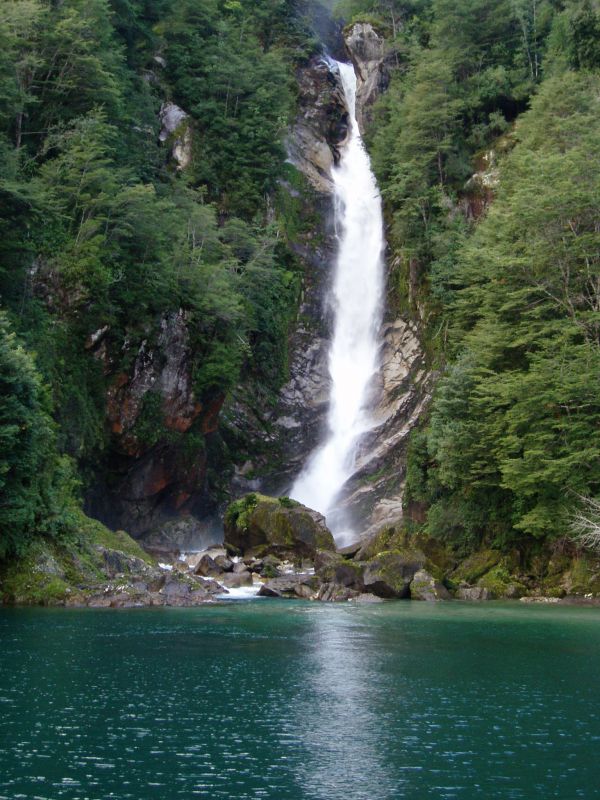
ROAD WITH SKIFF OF ASH
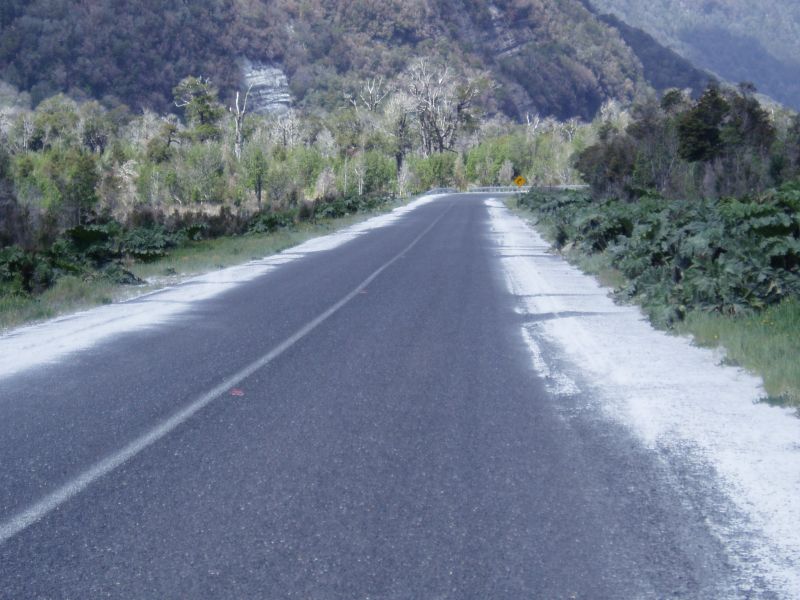
VOLCANO FROM CHAITEN
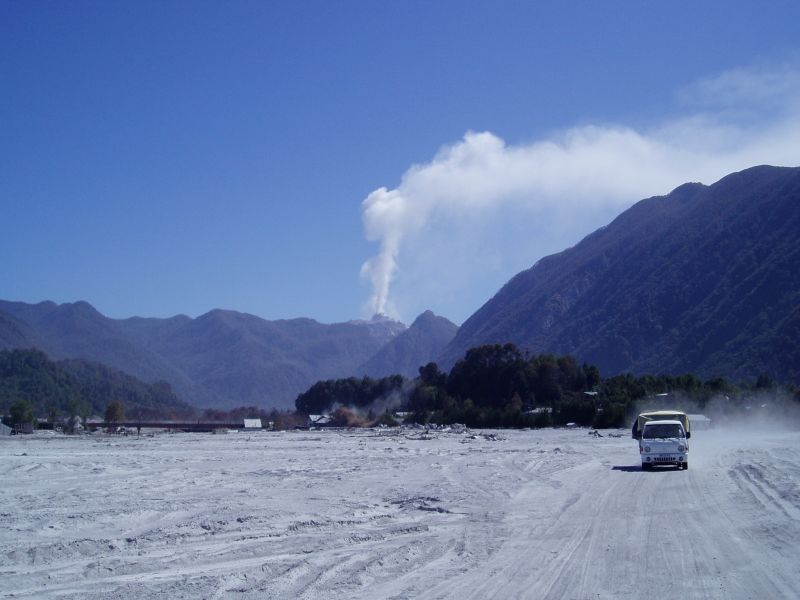
FISHING BAY OF LIONS
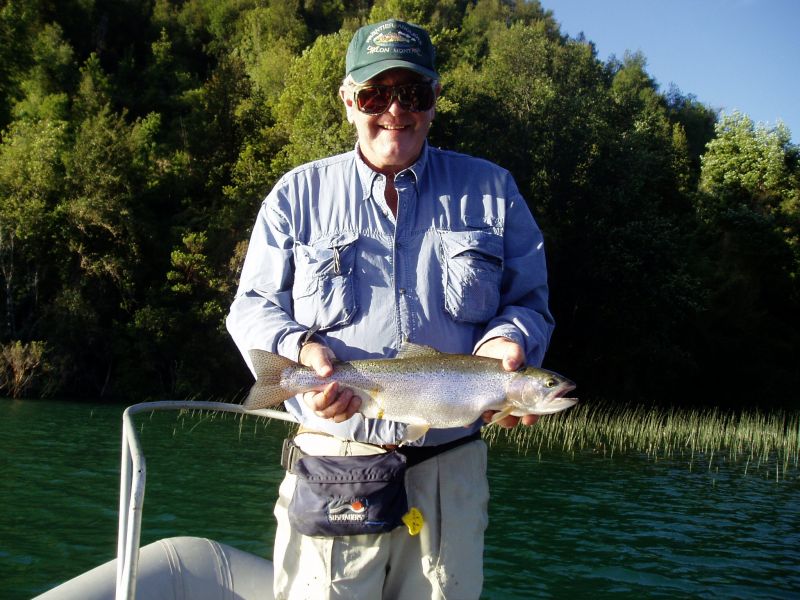
NICE FISH
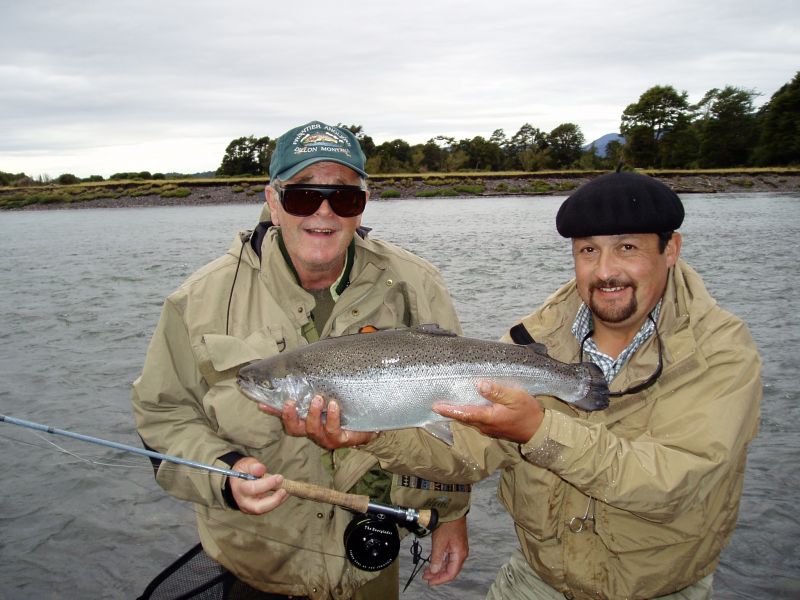
PUMA II IN PUERTO MONTT
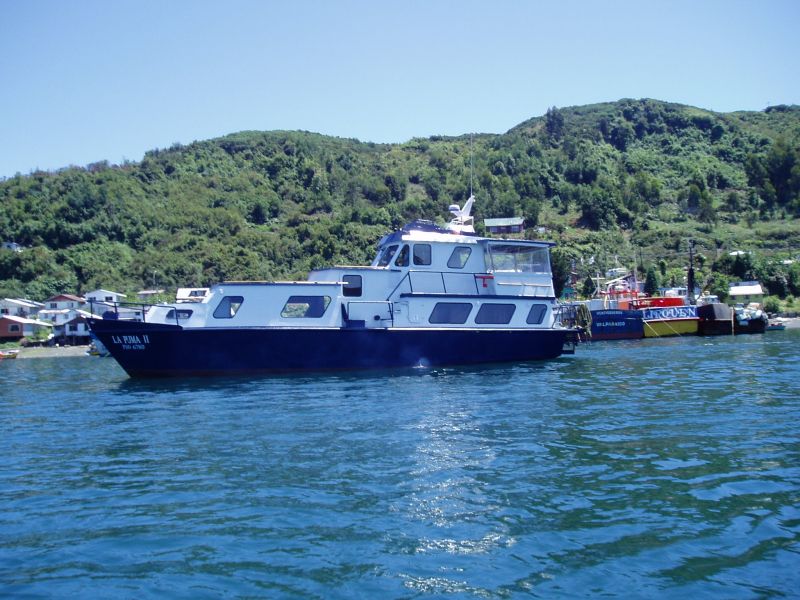
BELOW IS THE "OLD NEWS OF THE 07-08 SEASON AND THE ORDEAL OF THE ERUPTION WITH SOME INTERESTING PHOTOS, MAPS, ETC.. NOTE THAT THERE ARE TWO MOUNTAINS BETWEEN US AND THE VOLCANO AND THAT THE VALLEYS BETWEEN THE MOUNTAINS RUN AT RIGHT ANGLES TO THE VOLCANO DRAINAGE--SO WE ARE VERY SAFE FROM LEHARS ETC..
SUMMARY OF 07-08 SEASON
First off, the fishing was as good or probably better than we have experienced in the last twenty years of fishing this area. Reports of 50-60 fish/day/fisherperson were common with some reporting 100 plus days -- truly amazing! There seemed to be more Chinooks, especially in Rio Yelcho, (but still not enough, in my opinion, to offer it as a target species). The Steelhead and Atlantic fishing at the Blanco estuary was fantastic in the latter third of the season predominantly. The lower end of Lago Yelcho was very productive with some real mopnsters (on drys), to get the heart pounding! Rio Yelcho was very productive and monster Browns made their presents felt. Due to some governmental issues we were not (nor was anyone) able to fish the magical Lago Negro in Doug Tompkin's PUMALIN PARK, but we have been told that PUMA FISHING and only one other lodge will be granted permits to fish the lake in 08-09.
The new mothership/floating lodge, PUMA II was supposed to be finished and delivered to Lago Yelcho by the end of September 07, but is just now being completed in Puerto Montt and being readied for transport to the lake. It is indeed unfortunate that we did not have it for the season but it is quite a boat and we look forward to it being operational this coming season -- as many of our clients are.
We have experimented with some new flies for the lakes and have come up with some real productive ones. I hate to admit it but they out fished the dragon flies that our guides tie -- hands down, and they even produced during days when there was little sun and no significant dragon fly hatch.
We are considering going solar for some of our energy needs at the lodge. Patricio and the boys have made a road down to the river. It is about a mile downstream from the lodge where the creek that the bridge we walk across empties into the Yelchho. Therefore, if one does not want the 20 minute walk in, a 5 minute boat ride rather than a 20-30 minute boat ride from where the Rio Michimahuida comes into the Yelcho is now available and we still keep the tranquility and solitude that so many clients appreciate.
Clients (both fishing and nonfishing) have enjoyed PUMALIN PARK (one of the finest eco parks in the world); as well as trekking to glaciers.
Now booking for 08-09 --- don't get shut out on your desired dates.
GUIDE ALERT
This past season three USA guides were deported by Chilean authorities for not having proper papers and work visas. We expect this action to continue next season and even be stepped up. Our guides from the USA will be properly documented. Fortunately our Chilean guides are some of the very best in all of the Patagonia, have been with us for several years, know the waters that we fish very well and are truly members of our family. The same can be said for our guides from the USA, as many of you can attest to. It would be a shame to book a trip to the Patagonia and find that you have no guides, inexperienced guides, or guides that are not familiar with the waters. We feel that our clients deserve the best and we know that you get what you pay for when it comes to guides.
CHAITEN VOLCANO ERUPTION
The Chaiten Volcano located about 6 miles (10 km) from the town of Chaiten and about 20 miles (35 km) from the lodge erupted on May 2. This volcano, which has been inactive for over 9,000 years; sent ash over 20 miles into the air. Chaiten and the area of the lodge did not receive much ash accumulation because the ash was blown very high and the winds that were blowing in a Southeast direction at the time of the eruption sent the ash up over Lago Yelcho and on t0 the Chilean town of Futaleufu and the Argentine town of Esquel where it deposited over 20 cm of ash --- compared to only about 3 cm in our area nearer the volcano. There were several seismic tremors associated with the eruption.
I was informed of the eruption by my associate and manager, Patricio Soto shortly after the eruption at which time he said that they were told to evacuate Chaiten. Therefore he was going to have another employee, Adier, who was at the lodge stay there and Patricio would take his family and Adier's family to Puerto Montt on the evacuation ship/ferry as the authorities ordered. They arrived in Puerto Montt and since they had not eaten all day friends took them to a restaurant and when they came out they found that the car with their suitcases and Patricio's briefcase had been broken into and everything stolen. These poor people --- goes to show that a disaster brings out the best and worst of mankind the world over (even in the Chilean Patagonia). I sent funds to Patricio and at the present time (May 22), the two families are living in limbo in Puerto Montt where Patricio is monitoring the situation at Chaiten and the lodge while overseeing the final stages of finish work on the new floating lodge/mothership, PUMA II.
The Rio Blanco which runs through the town of Chaiten is the major body of water that is associated with the area of the Chaiten Volcano and after the eruption ash, mud, and debris in this river caused it to overflow and flood 90% of the town of 5,000 people --- Patricio since has related that the media reports of the extent of the flooding is significantly exaggerated as per conversations with pilots that have flown over the area and aerial photos that he has seen. There has been some rain which also adds to the flooding. The main thing that the flooding could do long term (other than the property damage from the flooding itself), is that if there is too high of an ash content in the flood water, when the water is gone the ash would tend to possibly set like concrete. Since ash in this area is not deep, hopefully this will not occur; but never the less the clean up is going to be a major undertaking and their will be significant property damage.
On May 6th there were two more significant eruptions and we were initially told that Adier was forced to leave the lodge by the authorities. But a week later we found out that he did not have to leave and was given an emergency network phone. One of Patricio's brothers is working at the emergency command center so Patricio has been able to communicate with Adier who reports that everything is okay as of May 22. Our water supply is not contaminated, there is no structural damage, there is less than an inch of ash, and the Rio Yelcho is okay.
The height of the eruption column has now decreased to a little over 4 miles in the air. Although it is just too early to accurately predict what is going to happen regarding this eruption, experts in the field have mentioned four possible scenarios. 1) The column of ash, molten rock and gases may continue to collapse and cause pyroclastic flows thus depositing these materials in fairly close proximity to the volcano, which may include Chaiten but most likely not the lodge. Environmental destruction in this immediate area could be severe -- one of the reasons for the forced evacuation. 2) The column may completely collapse and the dome of the volcano collapse on itself, then pressure build up and a large explosion occur like happened at Mt St Helen. The destruction from this would be severe but the area involved would depend on the size of the explosion -- another reason for the forced evacuation. 3) The volcano will continue to erupt as it has been doing -- thus keeping everyone in limbo. 4) The damn volcano will go back to sleep -- for another 9,000 years, I hope. The majority of volcano experts that I have read reports from on this eruption, including one that has been following this volcano for some years; feel that the most likely scenario is 4). I hope that they are right and that it happens soon!
As far as the watersheds that we fish are concerned, I believe that we are okay (barring a massive explosion). We should be okay at Lago Negro and Lago Blanco and their rivers as they are not fed from the area of the volcano (but they are only about 6-10 miles from the volcano so could be secondarily affected by some of the scenarios mentioned above). The Rio Yelcho should be okay as well and is no closer than about 10 miles near where it enters the ocean, and at its halfway point (from the lake to the ocean -- where the lodge is), the distance is over 20 miles. There is a remote possibility that heat from the volcano may cause some increase of melting of the Michimahuida Glacier/Volcano and this increase flow of the Michimahuida and Amarillo rivers which come into the Yelcho about 7 and 2 miles respectively above the lodge. . It is coming into winter so this will help offset any increased melting. The fish in the lake should be okay because the lake is deep and the fish are deep since it is winter.
Hopefully this will give you an overview of the eruption and its aftermath as well as some insight into how it will play out. The Chilean Government has went all the way from a scenario that the town of Chaiten is lost and all the people will have to be permanently relocated elsewhere -- to 2 years before they could go back to Chaiten -- to now saying that it will be up to 3 months before they can return. I imagine that this time frame will continue to shorten barring scenarios 1) or 2) explained above. These people want to get back to their homes, they want to assess the damage, and they want their possessions at least with them if they have to wait out the volcano elsewhere. Our hearts, thoughts, and prayers go out to our employees, their families, our friends and all of the people of the area including Chaiten. The same goes for Mr Tompkins, Mr Guzman, and the entire PUMALIN PARK personnel. Mr Tompkins has done so much for this area and I am sure that there will be a considerable amount of work necessary in the aftermath of the eruption of the Chaiten Volcano which is in PUMALIN PARK.
I will keep you informed of any significant developments -- good or bad. At least at this time, (May 22) it looks like my property is okay, the environmental impact on the areas that we fish is minimal, and my employees are safe. Thank God!
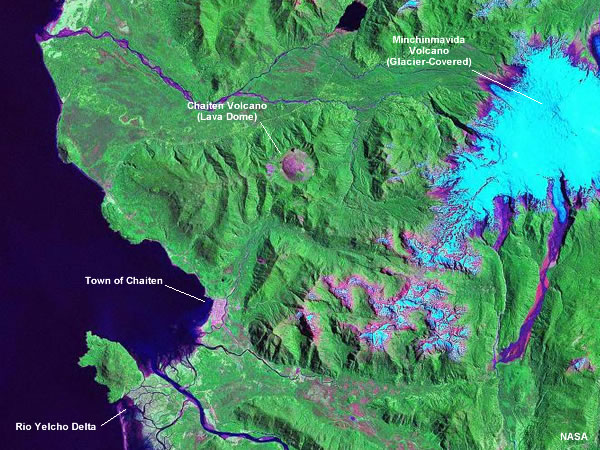
Chaiten Volcano is upper center; Lago Blanco is in upper center; Rio Yelcho is at lower left; and the lodge (not shown) would be about one inch below the lower right hand corner
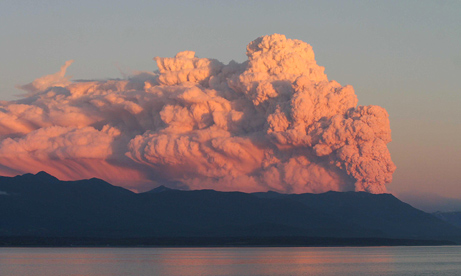
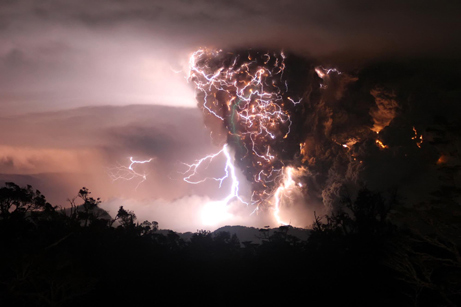
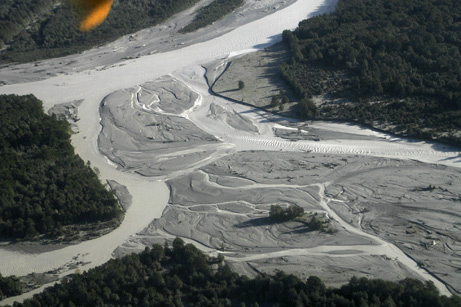
Yelcho River where the Amarillo River enters it (about 2 miles above the lodge. Aerial photo taken about middle of May 08. Note ash is minimal.
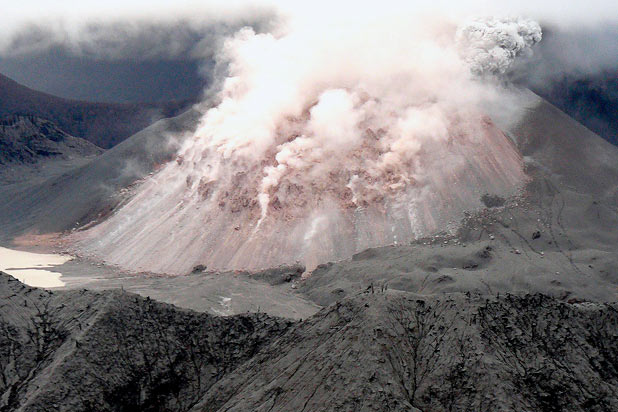
Chaiten Volcano about the end of May (4 weeks after initial eruption
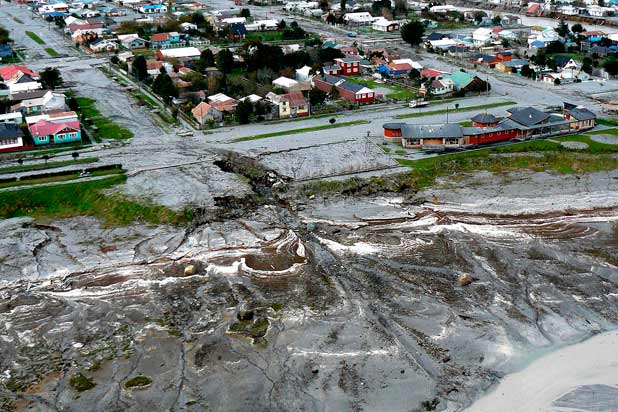
Chaiten taken towards the end of May. Note damage from flooding,ash and mud debris, but no new ash.
ERUPTION UPDATE---MAY 31
Unfortunately on about May 19, Adier was ordered to leave the lodge -- for what reasons we do not know. He reports that everything is fine at the lodge, (no ash, water not contaminated, all structures okay. There had been an increase in the magnitude of the seismic activity during the third week in May but the frequency of these tremors was down. Rio Yelcho was in good shape and no fish kill was observed. Adier has joined his family in Puerto Montt and his children are back in school there. Volcano experts say that the crater continues to dome more and a new eruption area has shown up at the margin of the primary crater that was formed when two areas joined earlier. The mandatory evacuation area has reportedly been decreased, therefore we hopefully will be able to return to the lodge soon (but will probably have to fly into another airport as the Chaiten airport will not be usable for some time). Again, I will keep you informed.
ERUPTION UPDATE---JULY 20
Unfortunately the volcano continues to rumble on, though at a much lower magnitude. As far as the damage to the town of Chaiten, the news is not good. The initial flooding of mud, ash, and debris was bad enough, but with the Rio Blanco's riverbed destroyed the normally heavy seasonal rains essentially about finished what the eruption started. Reports estimate 70-80% of the town severely damaged and the water, sewer, and electrical systems destroyed. There is serious question whether Chaiten can or will be rebuilt at its present site. Governmental decisions will probably not be made until the volcano goes back to sleep. Patricio and Adier were able to go to the lodge and also enter Chaiten about 10 days ago and begin removing possessions from their homes. I told them that we can build a building on the land near the lodge to store their items along with those of PF which we have to also remove from Chaiten. At that time they informed me that the lodge, Rio Yelcho, and Lago Yelcho are in good shape---THANK GOD! There is a no enter (now controlled enter) zone check point where the highway crosses over Rio Amarillo south of Chaiten. Our turn off to the lodge is less than a km north of the Amarillo bridge.
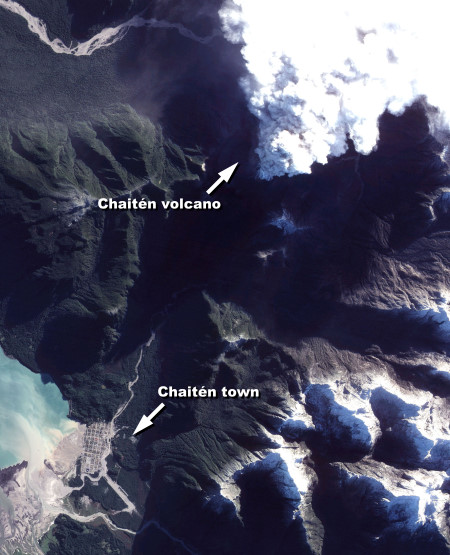
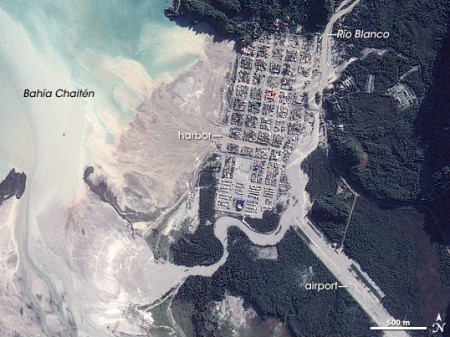
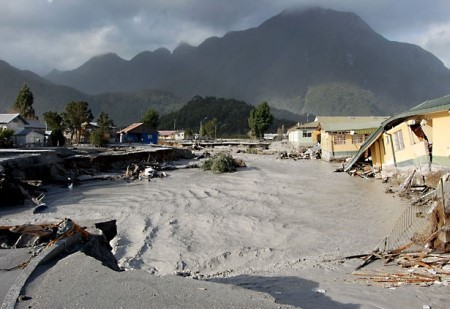
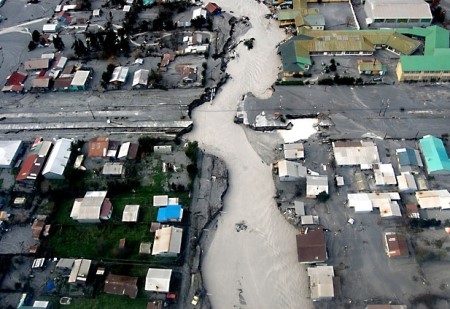
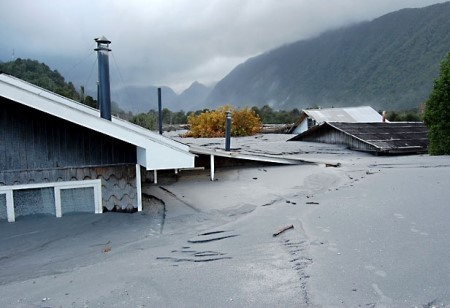
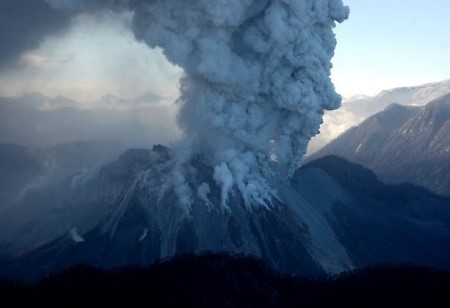
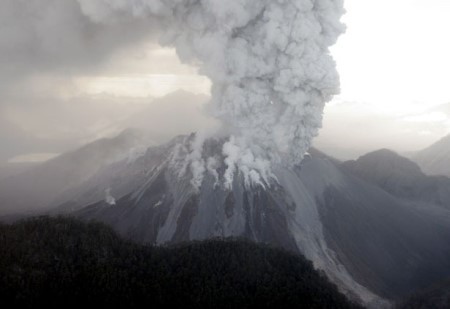
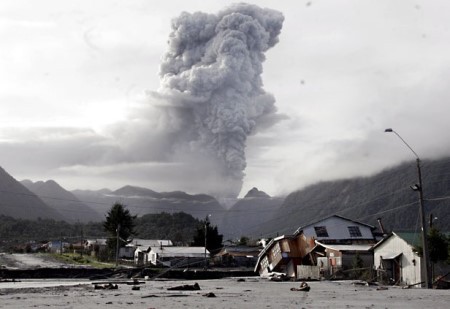
Patricio is overseeing the final stages of finish work on PUMA II in Puerto Montt-- this is work that we had intended to do at Lago Yelcho. The big question is going to be how to get PUMA II into Lago Yelcho. The highway north of Chaiten (which passes close to the volcano) apparently has significant damage; thus bringing the crane and truck from the north is now impossible. Therefore we will have to bring them from the south if possible. The other option that we are exploring at this time is to operate PUMA II in the fjord area between Puerto Montt and Chaiten, fishing the coastal rivers in this essentially unfished area. The few reports of fishing this area are truly mouthwatering to say the least! But there would be many logistic and scheduling problems to work out before I can offer it to clients. We most likely will not be able to fish Lago Negro this year and fishing the estuary of the other Rio Blanco is questionable at this time unless we go there via our covered catamaran or PUMA II. We may replace Lago Negro with another river/lake watershed further south. So we have several options which I believe is one of our biggest advantages and assets when compared to other lodge operations, and it is all close at hand.
I certainly am thankful that PF's assets are in good order, the fisheries appear to be fine, and my employees and their families are safe. Again, hopefully the volcano will go back to sleep as we are eagerly awaiting the start of the new season and look forward to sharing our amazing fisheries with our clients. I will keep you informed of our geologic drama.
UNDATE AS OF OCTOBER 10 AND PLANS FOR THE 08-09 SEASON
Finally the Chaiten Volcano has quieted down significantly and for the last several weeks water vapor is about all that is coming out. The road (Pan Am Highway) is now open again for travel to and from Puerto Montt and the south.
The Chilean government was going to remove the mud and ash (from Rio Blanco) off the end of the runway at the Chaiten airport and open it by the end of Sept., but have now changed their mind: apparently because they are afraid that the former residents of Chaiten will flock back in -- which the government is strongly opposed to. The government has not decided what to do about Chaiten and won't make a final decision until Nov. at the earliest; but most likely the end of the year -- if then. Not having the Chaiten airport open is an inconvenience because we will have to use 3 airports abit further south to fly clients into --- Futaluefu, La Junta, and Palena. So instead of a 30 minute drive to the lodge it will be a 1 1/2 - 2 1/2 hr drive. But at least our clients won't have to endure any significant "road trips" after they arrive as is often the norm with many lodge operations.
The lodge is in excellent shape and all the equipment being readied for the season. The waters that we fish are in excellent condition as well (remember that we received very little ash), with the possible exception of a small lake in Mr Doug Tompkins' PUMALIN PARK that we have had boats in for several years. This lake is closer to the volcano and Patricio will be checking it out in a few weeks.
Patricio is now busy with the final finish work detail on the new mothership/floating lodge, PUMA II, at the shipyard in Puerto Montt. Once this is completed all that is left is some final painting and testing of all systems. We hope to have the new boat travel to the Chaiten area and be brought by land up to its berth at Pto. Cardenas at Lago Yelcho in December. We are working on the details at this time as we are unable to bring the boat up the Rio Negro and load it on a truck with a crane next to the highway as originally planed because of silting in of the mouth of the river at the Bay of Chaiten. PUMA II is over a year behind schedule for its deployment in Lago Yelcho but it is a beautiful boat and we eagerly await its service, as do many of our clients that enjoyed the original PUMA so much in years past.
Therefore, since the volcano is finally quieting down, the road is open, we have airports to fly clients into, our lodge is in good order, PUMA II is almost done, and most importantly the waters that we fish are in good shape; we have decided to open for the 08-09 season. The first of the Chinook (King) Salmon have already been observed in the Yelcho River.
I will be getting the exact daily scheduling of the flights between Futaleufu, La Junta, Palena, and Puerto Montt soon and will post the schedule (and cost) here when I get it from Mireya.
There apparently will only be 1 or possibly 2 other lodges open in our area this season. So it will be like "the good old days" when I first came to the Yelcho as we will have everything pretty much to ourselves.
I am in the process of booking the clients that I have had to put on hold because of the volcano eruption as well as accommodate clients for lodges that will not be open this year. So I invite you to come and enjoy all that we have to offer, PUMALIN PARK, the glaciers, AND view an active (but quiet) volcano. Where in the world can a fisherperson experience this high quality fishing, beautiful scenery, AND a volcano? PUMA FISHING!
.jpg)
HOPEFULLY THE CHAITEN VOLCANO IS IN ITS SUNSET MODE AND WILL STAY THAT WAY FOR ANOTHER 9000 YEARS!
GOOD%20EDIT.JPG)
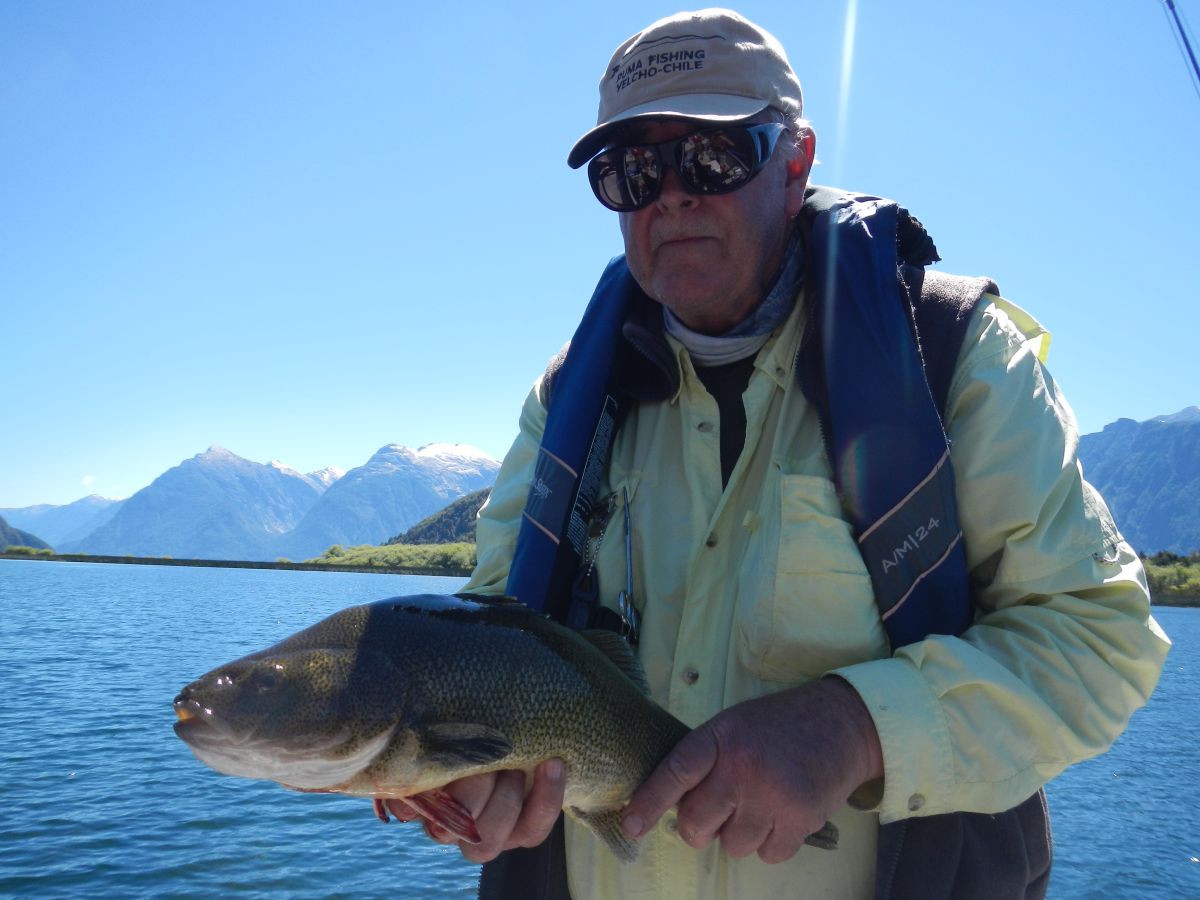
edited.JPG)
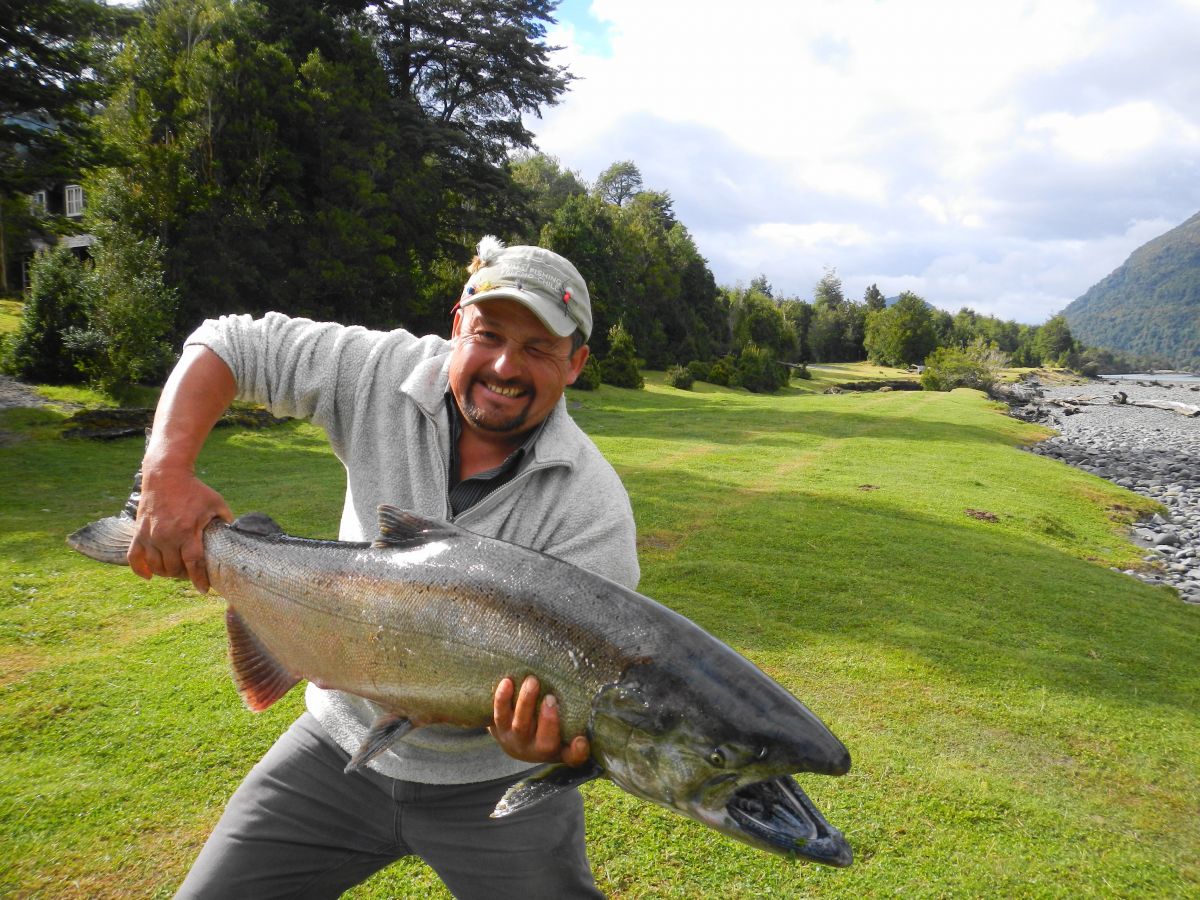
(corrected).JPG)
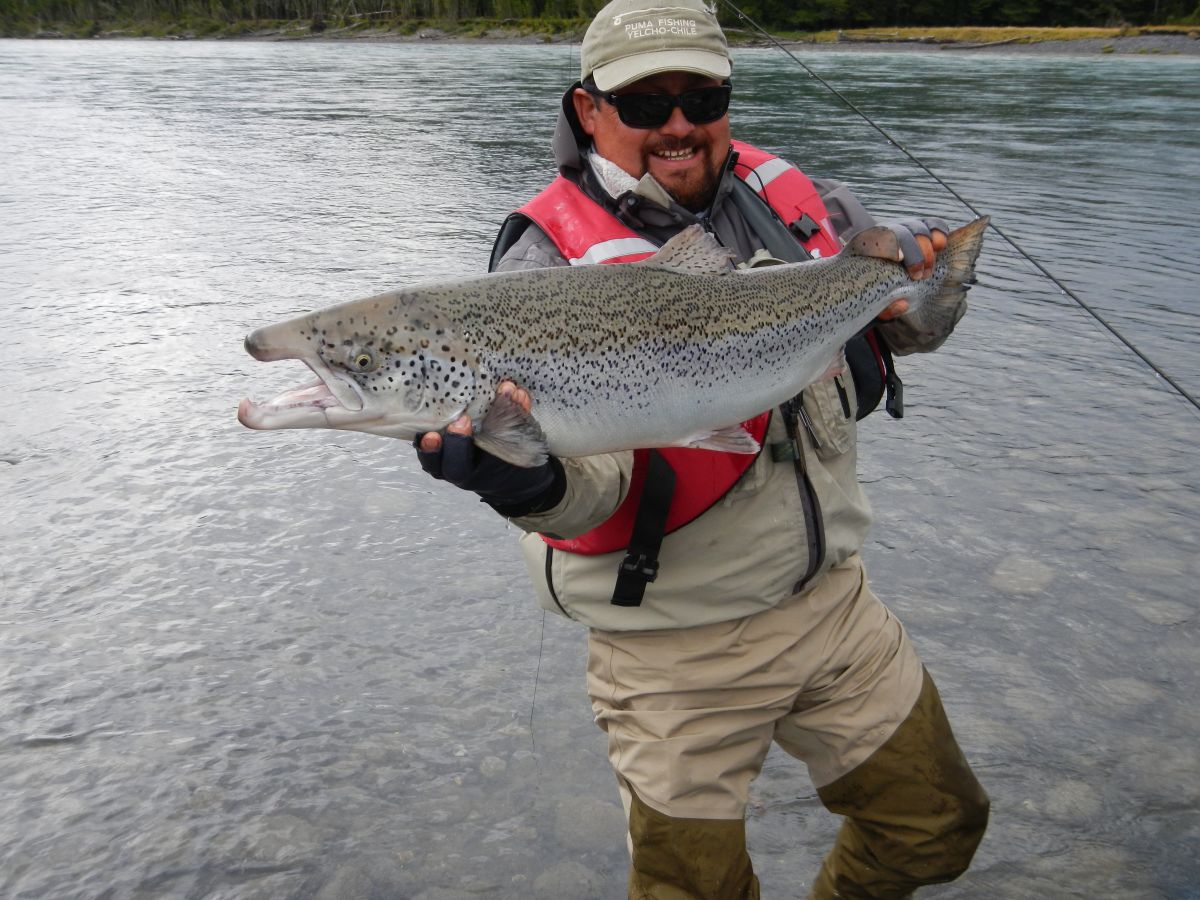
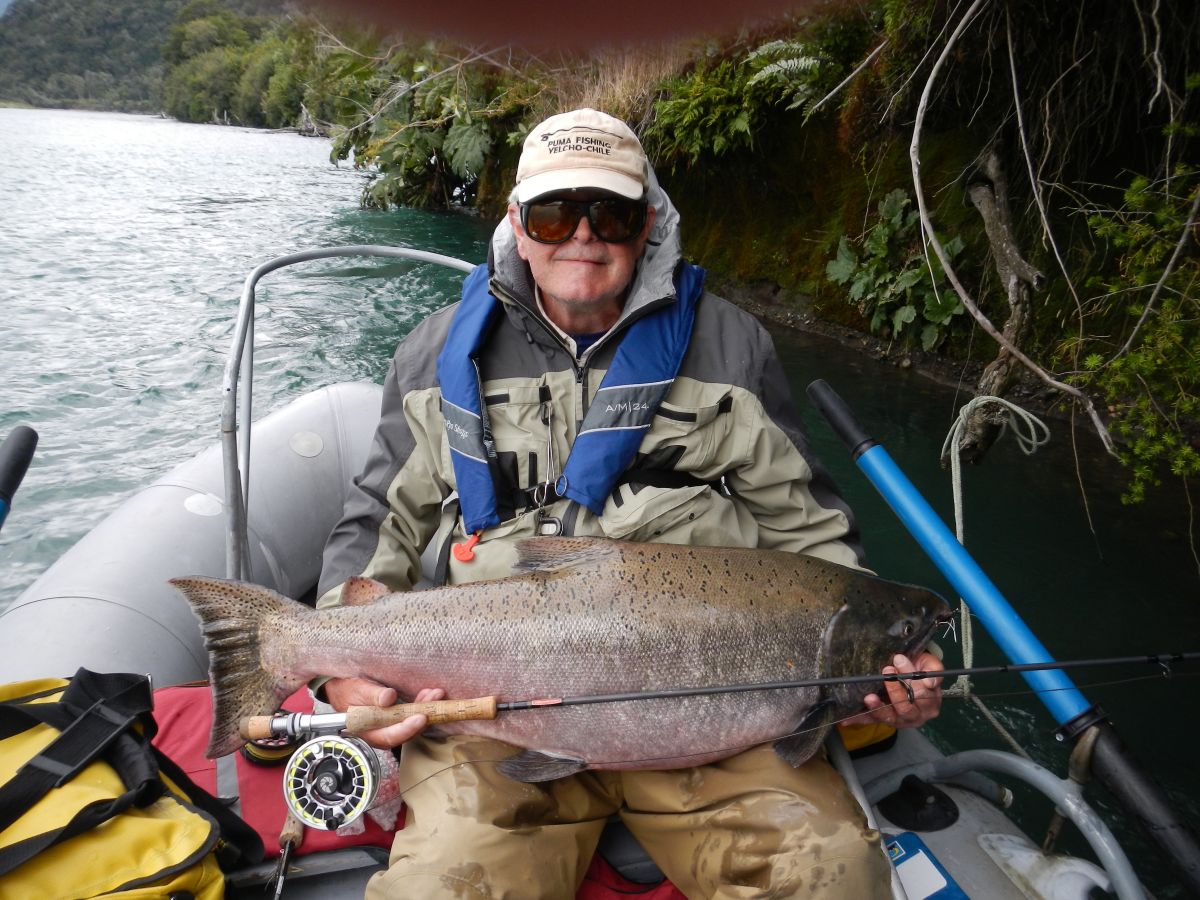
%20edit%20w%20date.JPG)
%20edit(1)%20w%20date.JPG)
%20edited%20monster.JPG)
